
- Forum Listing
- Marketplace
- Advanced Search
- Shocks and Suspension

Trek Reactive shocks
- Add to quote
Would love to get input on Treks reactive shock. I have a 2021 trek Fuel EX 8 XT on order ,I have heard mixed reviews about the reactive shock. This is my first full suspension bike and would prefer to not constantly have issues, so I am considering canceling the order. Any help would be much appreciated and bike suggestions in the 3500 price range would be welcome. Thanks Full Squish Clyde
I have the Fox Reaktiv shock on my 2020 Fuel EX 9.7. This is the same style that you'd be getting on the EX8. No issues whatsoever and it performs flawlessly. I can afford to replace it if I wanted to but I have yet to see any reason to do so.
May I ask how much you way?
You're probably overthinking this. Next to the Spec Stumpjumper the Trek Fuel line is probably the single most successful line of MTB models ever and it didn't get there by being a crap bike. For every grumpy owner there will be 99 who are perfectly happy. If you believe this thread, Penske Racing Shocks don't know their ass from their elbows and should be Walmart greeters instead.
rete said: If you believe this thread, Penske Racing Shocks don't know their ass from their elbows and should be Walmart greeters instead. Click to expand...
The reaktiv valve is pretty bad, but nowhere near as problematic as the thru shaft design, which is the most unreliable shock I’ve ever seen. I don’t publicly rubbish many products but I advise anyone looking at buying a trek to budget for a new shock in the purchase price
JohnnyC7 said: The reaktiv valve is pretty bad, but nowhere near as problematic as the thru shaft design, which is the most unreliable shock I've ever seen. I don't publicly rubbish many products but I advise anyone looking at buying a trek to budget for a new shock in the purchase price Click to expand...
Hi, I have a fuel ex 8 2021 and have not had any issues. i am a heeeaaavy rider (just under 300 lbs) and am running little under 300 psi and the shock feels great. Have not had it bottom out but have not did any large jumps. the fuel ex 8 does not have a thru shaft shock just the reactive version.
Thank You!!!
The reAktiv shock is basically a shock that tries to prevent pedal bob. Most shocks are progressive in that it starts off soft then progressively gets firmer, however the rate in which it firms up is what makes shocks different from each other regarding compression. The reAktiv shock is regressive, it starts off firm, then when enough force is applied to allow the shock to compress, it does. So Trek took the approach to fixing pedal bob by applying the solution to the shock. In comparison there's another approach, which is to address the pedal bob issue not at the shock, but through the leverage curve of the frame through higher anti-squat. The Evil bikes are this way. Without a special shock, they remain very firm under pedaling but allows the suspension to move very nicely when the bumps come along. However what most riders I've talked to and experienced first hand, it makes the bike really unstable when going over repeated hits. I'm much bigger than most riders and regardless of how many tokens and air pressure I can realistically use, it blows through the stroke way too much. I dislike this shock and would be one of the first things I replace. The people that might like reAktiv are XC riders that mostly ride on fireroads where nothing's really technical. Not much roots, rock gardens or anything gnarly. This doesn't make much sense since they have this shock on their enduro bikes that were designed for more than just fireroad riding. Everyone else would generally benefit from using a different shock. Trek had good intentions with reAktiv and thru-shaft, but in my experiences it doesn't provide good results.
My 1st gen. shock (2015) was problematic but the replacement has been flawless. I like how it performs for trail use. Keep in mind that all shocks need routine maintenance so if you're not willing to do that you should anticipate some poor function eventually.
Hi Nat Thanks for the feedback. I am aware of the yearly maintenance, I just have heard of issues of wheels braking because the shock is not working correctly. I am by know means going to be bombing this bike off giant jumps, but I am a heavier rider and small jumps seems to do some damage. Just want to be sure. Thanks again
I have no experience w/ Trek's Reactive shock but did own a DRCV suspended Trek. When I purchased the Trek I had been primarily on coil shocks. I had zero Trek experience, before the purchase, only to find the shock had a proprietary Trunnion mount. After owning a couple bikes w/ proprietary shocks I have since crossed them off my wish list.
My 2018 Reaktiv is under damped and when in the middle compression position the jolt before the Reaktiv valve opens is noticeable and then it's under damped. It's not bad enough to justify the cost of replacement but certainly not great. A mate had the same shock and replaced it with a DPX2, now has the 2020 through shaft Reaktiv and is happy with it.
PhillipJ said: My 2018 Reaktiv is under damped and when in the middle compression position the jolt before the Reaktiv valve opens is noticeable and then it's under damped. It's not bad enough to justify the cost of replacement but certainly not great. A mate had the same shock and replaced it with a DPX2, now has the 2020 through shaft Reaktiv and is happy with it. Click to expand...
They are intended to offer a firmer pedalling platform and then give up most of the damping as soon as they start moving. lighter riders seem okay with it. Bigger or more aggressive riders really hate it. The feel is inconsistent and they have to run a lot of air pressure and tokens to stop bottoming out all the time. I do a steady trade sending conversion pin kits worldwide for people to fit conventional shocks.
Thanks for the input!!! What does the pin kit do? Your getting to smart for me.
Ive only used the original Fox Reaktiv shock and I really liked the pedal mode which felt nothing like any other shock but it lacked the ability to add spacers so it bottomed out too easy (but they werent harsh bottom outs). The new shocks support spacers so I would assume the bottom out problem has been improved, the thru-shaft design is also completely different to the old ones though so all the old problems and benefits may be totally irrelevant.
Now i am curious if this issue is only on the thru shaft version or on all the Reaktiv shocks?
Follow the link. It's a webshop with international pricing in about 30 currencies. Most of the products are configurable so you can choose the options that fit. Sent from the Shockcraft mobile typewriter
Thank You I started typing before looking at the links. Your sight looks awesome!
I believe the through shaft is on some higher end carbon models. It’s not on the ex8. I believe you would be happy with the stock shock at this price range. If not there are other options down the road.
Jtsnipe said: I believe the through shaft is on some higher end carbon models. It's not on the ex8. I believe you would be happy with the stock shock at this price range. If not there are other options down the road. Click to expand...
Does anyone have a different option of bike at the 3500 Price range with equivalent component specs?
I thought that I had watched about all the trek ex8 videos out there and most of fuel ex other models but haven’t seen that issue. Now I have to do a search 😷. I’m guessing there is 20 to 30 thousand of these bikes out there but the squeaky wheel gets the grease.
Jtsnipe said: I thought that I had watched about all the trek ex8 videos out there and most of fuel ex other models but haven't seen that issue. Now I have to do a search ?. I'm guessing there is 20 to 30 thousand of these bikes out there but the squeaky wheel gets the grease. Click to expand...
Just to clarify I am not a Trek fanboy, I had a popular boutique brand that would not be available on order for months until this option happened
I should also include in my estimate S. M. L. Ex.
I rode a 2018 Trek Fuel 9.8 with a Reactiv shock for two seasons and could not get the bike dialed into my liking. Then I swapped out the shock for a Fox DPX2 and it was a huge improvement. Like others noted, midstroke seemed to be the problem. It rode too low in the travel for me and bottomed out too soon. I am about 205 in full kit and ride fairly aggressively. The shock didn't malfunction, and all I ever had to do was routine maintenance, but in my opinion, the shock design is flawed and the bike gets robbed of a lot of performance due to it.
This particular bike and suspension may not be the right choice for you at that weight. The trek suspension calculator only provides recommendations up to 250lbs and recommends contacting Fox above that weight. The bike itself is rated to 300lbs and that weight is supposed to include the bike, the rider, and all cargo.
Fully aware. I will not see the bike until April at the earliest (Probably June!!) and have a fairly aggressive workout regiment right now. I fully plan to be at 250 or less by then. There are many bike trips to be had in 2021!!
I own a '19 Trek Full Stache 8... 29x3.0 tires w/ 130mm travel, front and back. 3 riding budz own Fuel Ex's They haven't reported any issues w/ their ReAktiv shocks. Mind you, none of them are over 200lb's I however, am 245lb's in my birthday suit. It's one of 4 steeds in my quiver. It's probably done 17-20 rides. Noticed a day or two ago, that when the blue switch is in the firmest position... my rear shock makes a clunk sound when trying to cycle through its travel. In the other 2 positions, there's no clunk. Gonna take it in for servicing (under Warranty). I may look at other options out back, further down the road. Sent from my HD1900 using Tapatalk
targnik said: I own a '19 Trek Full Stache 8... 29x3.0 tires w/ 130mm travel, front and back. 3 riding budz own Fuel Ex's They haven't reported any issues w/ their ReAktiv shocks. Mind you, none of them are over 200lb's I however, am 245lb's in my birthday suit. It's one of 4 steeds in my quiver. It's probably done 17-20 rides. Noticed a day or two ago, that when the blue switch is in the firmest position... my rear shock makes a clunk sound when trying to cycle through its travel. In the other 2 positions, there's no clunk. Gonna take it in for servicing (under Warranty). I may look at other options out back, further down the road. Sent from my HD1900 using Tapatalk Click to expand...
Update: Trek acknowledge there is a problem with the ReAktiv rear shock on my Full Stache. They say the it (ReAktiv) part of shock needs repaired i.e. it's a known issue. But... they won't repair it under Warranty!? They'll charge me $180NZD to repair the ReAktiv part of shock or charge me the same to remove the ReAktiv function and just have a regular shock. I don't want the clunking and I don't want it to return, which it would likely after same ride period. So, I'm paying to remove ReAktiv... What a crock of BS!! [emoji243] [emoji90] Sent from my HD1900 using Tapatalk
That's a bunch of crap!
Well! With of this info I have decided to not by the Trek Fuel EX 8. I instead purchased a Santa Cruz Tallboy.
Good choice. The proprietary **** is mostly BS. In some cases, you get a slight performance increase with some proprietary part, but there are often significant disadvantages, even for performance, and when it comes time that said part has to be replaced or serviced a few years down the road, you often end up screwed. In the end, you aren't getting anything that performs better than other good stuff, like SC, but you are taking a hit in compatibility and ability to get stuff down the road.
yes, the trek shock is not well-loved, but FWIW the trek Fuel EX shock sizing is standard 210x55 and you can run a non-trunnion PIGGYBACK shock with a readily-available adapter axle that is OE spec on their lower-end builds. The tallboy cannot even FIT an external reservoir, so there's that. Congrats on the bike, and no offense intended, but Santa Cruz messed up worse than Trek if you ask me.
Well here is a piston from a 2017 era Rockshox ReAktiv which somehow came detached from the damper rod, you can see from the three U shape ports there are cracks/fractures leading to a total replacement of the shock as the pistons are not available ! Never buy proprietory parts !
Attachments
- gen.0000000005453_rev_b_2018_reaktiv_thrushaft_service_manual.pdf 7.6 MB Views: 322

- ?
- 15.5M posts
- 516K members
Top Contributors this Month
- FIRST LOOK: KNOLLY BIKES’ NEW AND IMPROVED FUGITIVE
FIRST RIDE IMPRESSIONS: YETI’S NEW MIXED WHEEL SB165
FIRST RIDE IMPRESSIONS: GIANT’S NEW TRANCE X ADVANCED
MRP INTRODUCES NEW DAMPER FOR ROCKSHOX AND FOX FORKS WITH CUSTOM TUNES
MALIBU MOUNTAIN BIKER FLIES TO TEXAS TO SHOOT THE ECLIPSE
- FIRST LOOK: RACE FACE’S ALL NEW ERA AND TURBINE HANDLEBARS ARE DESIGNED TO COUNTER ARM PUMP
- FIRST LOOK: DVO’S NEW DIAMOND 36 FORK
- FIRST RIDE: ROCKY MOUNTAIN’S ALL-NEW ALTITUDE
- RILEY AMOS TAKES ON CHRISTOPHER BLEVINS IN BATTLE FOR U.S. OLYMPIC TEAM
- FIRST LOOK: FOX INTRODUCES NEW LINE OF GRIP DAMPERS & 32 STEP-CAST FORK

TREK RE:AKTIV XC SHOCK TEST
Trek re:aktiv xc shock.
An Efficient Platform for the XC Faithful

Trek’s RE:aktiv technology has been at the heart of its suspension designs, which range from cross-country to downhill. The needs of cross-country racers and riders are drastically different from those of dedicated downhill shredders, and Trek has addressed this with an XC-specific shock tune.
We have spent plenty of time with RE:aktiv technology on various trail-and enduro bikes and were eager to experience the difference with the XC version. Our test riders put this shock design to the test with long days in the saddle and intense cross-country races in search of personal records and podium finishes.
Tech Info: Trek developed its RE:aktiv technology in conjunction with Penske Racing Shocks after seeing how effective the design was in Formula One racing. RE:aktiv is a regressive design that gives riders a firm pedaling platform but also a smooth, controlled feeling when the suspension is activated. Trek engineers believe this technology offers the most effective balance between pedaling support and progressiveness throughout the suspension travel.
The RE:aktiv technology on Trek’s trail and aggressive trailbikes uses three different levels of damping. Trek designed the XC version with two modes—an open RE:aktiv setting and a firmer climb setting. This treatment uses a higher gas charge in the chamber than the normal RE:aktiv to achieve the extra support needed for the modern XC rider. Trek uses a Trunnion mount for the shock to allow for a more stable platform and a mechanical, remote, under-the-bar lockout to toggle between the two settings on the fly. This shock design is only available on Trek’s Top Fuel line.
On the Trail: We tested the RE:aktiv XC on a Trek Top Fuel that we have used for long-term testing. Initially, we started with a RockShox Monarch with a standard shock tune. After a couple months of riding, Trek sent us a Fox Float with the RE:aktiv XC tune for a back-to-back comparison. Our main test rider set the sag at 25 percent with seven clicks of rebound. The XC tune comes with an under-the-bar mechanical lockout lever for quick access on the racecourse.
Our first ride proved that this suspension platform is dedicated to pedaling efficiency and speed. Seated in the open mode, our test riders felt little to no unwanted movement from the shock. In the climb setting, the platform was even firmer, feeling more like a hardtail than any other suspension design we have tested in recent memory. Over ruts and minor obstacles in the trail, the shock was firm but active and smooth on bigger hits and drops. Some of our test riders felt that the climb mode was too stiff for technical singletrack and preferred to leave the shock open.
On the racecourse, the shock felt stiff and supported pedaling hard out of the saddle and when seated. The remote lockout made on-the-fly adjustments quick and allowed our test riders to focus on the trail rather than reaching down to switch settings. After several rides with the RE:aktiv XC, most of our test riders found themselves leaving the shock open for the duration of their rides. At the end of long days in the saddle, the climb setting offered a nice extra bit of efficiency. The RE:aktiv XC is a very specific design that works well in its natural habitat. Cross-country riders looking for that extra bit of support and speed will find plenty of versatility in this design to suit whatever type of course they are racing or riding.
• Efficient pedaling platform • Smooth travel on big hits • Comfortable during long days
• Climb mode will be too stiff for some riders
THERE ARE SO MANY WAYS TO GET MOUNTAIN BIKE ACTION
Mountain Bike Action is a monthly magazine devoted to all things mountain biking (yes, that’s 12 times a year because we never take a month off of mountain biking). It has been around since 1986 and we’re still having fun. Start a subscription by clicking here or calling (800) 767-0345.
Available from the Apple Newsstand for reading on your iPad, iPhone or iPod Touch.
Subscribe Here
Contact us via email at [email protected] ____________________________________

Photo of the Day: Click Here to See Who Won His Fifth World Cup Title This Weekend
Photo of the Day: Anton Cooper
mountainbikeaction
- Since 1986 - Covering All Aspects of ⛰🚲 #MBAmagazine

We and our {{count}} partners use cookies and other tracking technologies to improve your experience on our website. We may store and/or access information on a device and process personal data, such as your IP address and browsing data, for personalised advertising and content, advertising and content measurement, audience research and services development. Additionally, we may utilize precise geolocation data and identification through device scanning.
Please note that your consent will be valid across all our subdomains. You can change or withdraw your consent at any time by clicking the “Consent Preferences” button at the bottom of your screen. We respect your choices and are committed to providing you with a transparent and secure browsing experience.
Privacy Overview
- Most purposes explained in this notice rely on the storage or accessing of information from your device when you use an app or visit a website. For example, a vendor or publisher might need to store a cookie on your device during your first visit on a website, to be able to recognise your device during your next visits (by accessing this cookie each time).
- A car manufacturer wants to promote its electric vehicles to environmentally conscious users living in the city after office hours. The advertising is presented on a page with related content (such as an article on climate change actions) after 6:30 p.m. to users whose non-precise location suggests that they are in an urban zone.
- A large producer of watercolour paints wants to carry out an online advertising campaign for its latest watercolour range, diversifying its audience to reach as many amateur and professional artists as possible and avoiding showing the ad next to mismatched content (for instance, articles about how to paint your house). The number of times that the ad has been presented to you is detected and limited, to avoid presenting it too often.
- If you read several articles about the best bike accessories to buy, this information could be used to create a profile about your interest in bike accessories. Such a profile may be used or improved later on, on the same or a different website or app to present you with advertising for a particular bike accessory brand. If you also look at a configurator for a vehicle on a luxury car manufacturer website, this information could be combined with your interest in bikes to refine your profile and make an assumption that you are interested in luxury cycling gear.
- An apparel company wishes to promote its new line of high-end baby clothes. It gets in touch with an agency that has a network of clients with high income customers (such as high-end supermarkets) and asks the agency to create profiles of young parents or couples who can be assumed to be wealthy and to have a new child, so that these can later be used to present advertising within partner apps based on those profiles.
- An online retailer wants to advertise a limited sale on running shoes. It wants to target advertising to users who previously looked at running shoes on its mobile app. Tracking technologies might be used to recognise that you have previously used the mobile app to consult running shoes, in order to present you with the corresponding advertisement on the app.
- A profile created for personalised advertising in relation to a person having searched for bike accessories on a website can be used to present the relevant advertisement for bike accessories on a mobile app of another organisation.
- You read several articles on how to build a treehouse on a social media platform. This information might be added to a profile to mark your interest in content related to outdoors as well as do-it-yourself guides (with the objective of allowing the personalisation of content, so that for example you are presented with more blog posts and articles on treehouses and wood cabins in the future).
- You have viewed three videos on space exploration across different TV apps. An unrelated news platform with which you have had no contact builds a profile based on that viewing behaviour, marking space exploration as a topic of possible interest for other videos.
- You read articles on vegetarian food on a social media platform and then use the cooking app of an unrelated company. The profile built about you on the social media platform will be used to present you vegetarian recipes on the welcome screen of the cooking app.
- You have viewed three videos about rowing across different websites. An unrelated video sharing platform will recommend five other videos on rowing that may be of interest to you when you use your TV app, based on a profile built about you when you visited those different websites to watch online videos.
- You have clicked on an advertisement about a “black Friday” discount by an online shop on the website of a publisher and purchased a product. Your click will be linked to this purchase. Your interaction and that of other users will be measured to know how many clicks on the ad led to a purchase.
- You are one of very few to have clicked on an advertisement about an “international appreciation day” discount by an online gift shop within the app of a publisher. The publisher wants to have reports to understand how often a specific ad placement within the app, and notably the “international appreciation day” ad, has been viewed or clicked by you and other users, in order to help the publisher and its partners (such as agencies) optimise ad placements.
- You have read a blog post about hiking on a mobile app of a publisher and followed a link to a recommended and related post. Your interactions will be recorded as showing that the initial hiking post was useful to you and that it was successful in interesting you in the related post. This will be measured to know whether to produce more posts on hiking in the future and where to place them on the home screen of the mobile app.
- You were presented a video on fashion trends, but you and several other users stopped watching after 30 seconds. This information is then used to evaluate the right length of future videos on fashion trends.
- The owner of an online bookstore wants commercial reporting showing the proportion of visitors who consulted and left its site without buying, or consulted and bought the last celebrity autobiography of the month, as well as the average age and the male/female distribution of each category. Data relating to your navigation on its site and to your personal characteristics is then used and combined with other such data to produce these statistics.
- An advertiser wants to better understand the type of audience interacting with its adverts. It calls upon a research institute to compare the characteristics of users who interacted with the ad with typical attributes of users of similar platforms, across different devices. This comparison reveals to the advertiser that its ad audience is mainly accessing the adverts through mobile devices and is likely in the 45-60 age range.
- A technology platform working with a social media provider notices a growth in mobile app users, and sees based on their profiles that many of them are connecting through mobile connections. It uses a new technology to deliver ads that are formatted for mobile devices and that are low-bandwidth, to improve their performance.
- An advertiser is looking for a way to display ads on a new type of consumer device. It collects information regarding the way users interact with this new kind of device to determine whether it can build a new mechanism for displaying advertising on this type of device.
- A travel magazine has published an article on its website about the new online courses proposed by a language school, to improve travelling experiences abroad. The school’s blog posts are inserted directly at the bottom of the page, and selected on the basis of your non-precise location (for instance, blog posts explaining the course curriculum for different languages than the language of the country you are situated in).
- A sports news mobile app has started a new section of articles covering the most recent football games. Each article includes videos hosted by a separate streaming platform showcasing the highlights of each match. If you fast-forward a video, this information may be used to select a shorter video to play next.
- An advertising intermediary delivers ads from various advertisers to its network of partnering websites. It notices a large increase in clicks on ads relating to one advertiser, and uses data regarding the source of the clicks to determine that 80% of the clicks come from bots rather than humans.
- Clicking on a link in an article might normally send you to another page or part of the article. To achieve this, 1°) your browser sends a request to a server linked to the website, 2°) the server answers back (“here is the article you asked for”), using technical information automatically included in the request sent by your device, to properly display the information / images that are part of the article you asked for. Technically, such exchange of information is necessary to deliver the content that appears on your screen.
- Store and/or access information on a device
- Use limited data to select advertising
- Create profiles for personalised advertising
- Use profiles to select personalised advertising
- Measure advertising performance
- Measure content performance
- Understand audiences through statistics or combinations of data from different sources
- Develop and improve services
- Ensure security, prevent and detect fraud, and fix errors
- Deliver and present advertising and content
- Match and combine data from other data sources
- Link different devices
- Identify devices based on information transmitted automatically
- IP addresses
- Device identifiers
- Probabilistic identifiers
- Browsing and interaction data
- Non-precise location data
- Users’ profiles
- Privacy choices
- Tracking method : Cookies
- Maximum duration of cookies : 90 days
- Cookie lifetime is being refreshed
- Actively scan device characteristics for identification
- Device characteristics
- Tracking method : Cookies and others.
- Maximum duration of cookies : 365 days
- Use precise geolocation data
- Authentication-derived identifiers
- Precise location data
- Maximum duration of cookies : 30 days
- Cookie lifetime is not being refreshed
- Measure advertising performance ( Data Retention Period : 90 days )
- Maximum duration of cookies : 395 days
- User-provided data
- Maximum duration of cookies : 396 days
- Maximum duration of cookies : 394 days
- Create profiles to personalise content
- Maximum duration of cookies : 17 days
- Use profiles to select personalised content
- Use limited data to select content
- Maximum duration of cookies : 540 days
- Maximum duration of cookies : 3628 days
- Maximum duration of cookies : 180 days
- Maximum duration of cookies : 183 days
- Maximum duration of cookies : 397 days
- Maximum duration of cookies : 182 days
- Use profiles to select personalised advertising ( Data Retention Period : 180 days )
- Maximum duration of cookies : 390 days
- Maximum duration of cookies : 3650 days
- Maximum duration of cookies : 45 days
- Create profiles for personalised advertising ( Data Retention Period : 365 days )
- Use profiles to select personalised advertising ( Data Retention Period : 365 days )
- Measure advertising performance ( Data Retention Period : 365 days )
- Maximum duration of cookies : 730 days
- Maximum duration of cookies : 720 days
- Maximum duration of cookies : 21 days
- Maximum duration of cookies : 2555 days
- Maximum duration of cookies : 400 days
- Maximum duration of cookies : 273 days
- Maximum duration of cookies : 60 days
- Maximum duration of cookies : 393 days
- Create profiles for personalised advertising ( Data Retention Period : 90 days )
- Use profiles to select personalised advertising ( Data Retention Period : 90 days )
- Use profiles to select personalised advertising ( Data Retention Period : 390 days )
- Maximum duration of cookies : 2190 days
- Maximum duration of cookies : 364 days
- Use profiles to select personalised advertising ( Data Retention Period : 4320 days )
- Understand audiences through statistics or combinations of data from different sources ( Data Retention Period : 90 days )
- Develop and improve services ( Data Retention Period : 90 days )
- Maximum duration of cookies : 366 days
- Maximum duration of cookies : 120 days
- Maximum duration of cookies : 403 days
- Use profiles to select personalised advertising ( Data Retention Period : 0 days )
- Maximum duration of cookies : 729 days
- Maximum duration of cookies : 62 days
- Maximum duration of cookies : 1825 days
- Maximum duration of cookies : 25 days
- Maximum duration of cookies : 0 days
- Maximum duration of cookies : 1 days
- Maximum duration of cookies : 50 days
- Maximum duration of cookies : 14 days
- Maximum duration of cookies : 913 days
- Create profiles for personalised advertising ( Data Retention Period : 395 days )
- Use profiles to select personalised advertising ( Data Retention Period : 395 days )
- Create profiles to personalise content ( Data Retention Period : 395 days )
- Use profiles to select personalised content ( Data Retention Period : 395 days )
- Measure advertising performance ( Data Retention Period : 395 days )
- Measure content performance ( Data Retention Period : 1125 days )
- Understand audiences through statistics or combinations of data from different sources ( Data Retention Period : 1125 days )
- Develop and improve services ( Data Retention Period : 1125 days )
- Maximum duration of cookies : 18 days
- Maximum duration of cookies : 93 days
- Maximum duration of cookies : 386 days
- Maximum duration of cookies : 89 days
- Maximum duration of cookies : 1095 days
- Maximum duration of cookies : 500 days
- Maximum duration of cookies : 91 days
- Maximum duration of cookies : 912 days
- Maximum duration of cookies : 370 days
- Maximum duration of cookies : 9 days
- Create profiles for personalised advertising ( Data Retention Period : 10 days )
- Maximum duration of cookies : 360 days
- Maximum duration of cookies : 15 days
- Maximum duration of cookies : 31 days
- Maximum duration of cookies : 1157 days
- Maximum duration of cookies : 30000 days
- Maximum duration of cookies : 7 days
- Maximum duration of cookies : 730000 days
- Maximum duration of cookies : 300 days
- Maximum duration of cookies : 28 days
- Use profiles to select personalised advertising ( Data Retention Period : 7 days )
- Measure advertising performance ( Data Retention Period : 7 days )
- Create profiles for personalised advertising ( Data Retention Period : 0 days )
- Create profiles to personalise content ( Data Retention Period : 0 days )
- Use profiles to select personalised content ( Data Retention Period : 0 days )
- Measure advertising performance ( Data Retention Period : 0 days )
- Measure content performance ( Data Retention Period : 730 days )
- Understand audiences through statistics or combinations of data from different sources ( Data Retention Period : 730 days )
- Develop and improve services ( Data Retention Period : 730 days )
- Maximum duration of cookies : 2485 days
- Maximum duration of cookies : 2 days
- Maximum duration of cookies : 4 days
- Maximum duration of cookies : 146 days
- Maximum duration of cookies : 13 days
- Maximum duration of cookies : 356 days
- Create profiles for personalised advertising ( Data Retention Period : 180 days )
- Create profiles to personalise content ( Data Retention Period : 90 days )
- Develop and improve services ( Data Retention Period : 120 days )
- Maximum duration of cookies : 358 days
- Maximum duration of cookies : 57 days
- Create profiles to personalise content ( Data Retention Period : 91 days )
- Use profiles to select personalised content ( Data Retention Period : 91 days )
- Measure advertising performance ( Data Retention Period : 91 days )
- Understand audiences through statistics or combinations of data from different sources ( Data Retention Period : 91 days )
- Develop and improve services ( Data Retention Period : 4320 days )
- Maximum duration of cookies : 3652 days
- Maximum duration of cookies : 56 days
- Maximum duration of cookies : 3000 days
- Bike Builds
- Cross Country Bikes
- Downhill Bikes
- Enduro Bikes
- Hardtail Bikes
- Trail Bikes
ENDURA MT500 WATERPROOF JACKET II REVIEW
FOX FLEXAIR PRO GLOVE REVIEW – DURABLE AND PROTECTIVE RIGHT WHERE YOU NEED IT
BSC PRESS-FIT BOTTOM BRACKET INSTALLER AND REMOVER TOOL REVIEW
SHOOTOUT: THE THREE BEST ALLOY WHEELS WITH CARBON WARRANTIES GO HEAD TO HEAD
VIDEO: ‘SWAPPING LINES’ EPISODE 2 WITH GREG MINNAAR
THROWBACK THURSDAY: YOUNG STEVE PEAT TAKES US BACK TO 1993 IN DOWNHILL RACE VIDEO
VIDEO REPLAY: CRANKWORX ROTORUA WOMEN’S SLOPESTYLE EVENT, MARCH 2024
CRANKWORX ROTORUA SPEED AND STYLE VIDEO
ASK MBA: WHY DO MY BIKE’S DISC BRAKE PADS KEEP RUBBING?
ASK MBA: WHY AM I HAVING TROUBLE ALIGNING SHIMANO MICROSPLINE COGS?
ASK MBA: HOW DO I PICK THE RIGHT LENGTH DROPPER SEATPOST?
ASK MBA: SHOULD I BUY A CARBON OR ALUMINUM FRAME?
THE INS AND OUTS OF FRAME PROTECTION – THE BEST WAYS TO KEEP YOUR FRAME LOOKING…
HOW TO SERVICE A PRESS-FIT BOTTOM BRACKET
ASK MBA: SHOULD YOU REPLACE THE ROTOR ALONG WITH YOUR BRAKE PADS?
ASK MBA: HOW DO I DIAL IN MY FOX 34 FORK?
MATHIEU VAN DER POEL TELLS US ABOUT HIMSELF AND HIS MOUNTAIN BIKE, MBA SEPTEMBER 202O
BIKE CHECK: LARS FORSTER’S THÖMUS LIGHTRIDER WORLDCUP
The Greatest Riders in Mountain Bike History (Updated)
BIKE CHECK: ISABELLA NAUGHTON’S LIV ENDURO RACE MACHINE
- Mountain Bike Action
- Digital Mountain Bike Action
- Back Issues
- NICA Team of the Month
- B’s Buzz
DESTINATION SLOVENIA – RIDING BENEATH THE EARTH
CANADA’S UNTAMED PARADISE – RIDING IN THE SOUTH CHILCOTIN MOUNTAINS
TEN REASONS TO RIDE SANTA FE NEW MEXICO
5 BIKE PARKS THAT ARE OPEN IN THE WINTER
CAPE EPIC STAGE 4 RESULTS AND FULL STAGE VIDEO
CAPE EPIC STAGE 3 RESULTS AND FULL STAGE VIDEO
DURANGO DERBY ANNOUNCES $10k PRO CASH PURSE
RED BULL HARDLINE IS HEATING UP
READER SENDS: THIS MONTH’S BEST READER-SUBMITTED PHOTOS
READER SENDS – THIS MONTH’S BEST READER SUBMITTED PHOTOS
READER SENDS – THIS MONTH’S BEST READER SUBMITTED PHOTOS
- Anneke’s Blog
- Down The Trail
- Bikes / Frames
- Sealants & Flat Protection
- Tubeless Tape & Kits
- Tubeless Valve Stems
- Misc. Valve Parts
- Suspension Forks
- Rigid Forks
- Fork Parts / Service
- Rear Shock Parts / Service
- Groupsets / Drivetrain Bundles
- Cranks / Cranksets
- Crank Parts
- Bottom Brackets
- Rear Derailleurs
- Derailleur Hangers / Parts
- Chainguides
- Chainring Bolts
- Chain Tensioners
- Single Speed Cogs / Kits
- Front Derailleurs
- MTB Right Hand Shifters
- MTB Shifter Sets
- MTB Left Hand Shifters
- Drop-bar Right Hand Shifters
- Drop-bar Left Hand Shifters
- Drop-bar Shifter Sets
- Drop-bar Hydraulic Brake / Shift Levers
- Shifter Parts
- MTB Handlebars
- Drop Bars (Gravel, CX, Road)
- Handlebar Tape
- Disc Brakes
- Disc Brake Rotors
- Disc Brake Adaptors
- Disc Brake Parts
- Road Caliper Brakes
- Cable Pull Brake Levers
- Dropper Posts
- Dropper Post Remotes / Levers
- Rigid Seatposts
- Seatpost Parts / Shims / Misc.
- Seatpost Clamps
- Suspension Seatposts
- Saddles / Seats
- Flat Pedals
- Clipless Pedals
- Pedal Small Parts
- Front Wheels
- Rear Wheels
- Rim Tape & Kits
- Complete Headsets
- Headset Spacers
- Headset Parts
- Shifter Cable & Housing
- Brake Cable & Housing
- Misc. Cable Parts
- Multi-Tools
- Chain & Other Lube
- Fork Oils & Lubes
- Grease & Assembly Compound
- Repair Stands
- General Bike Tools
- Hex / Allen Wrenches
- Component Specific Tools
- Tire & Tube Repair
- Frame Tools
- Wheel Tools
- Cleaning Tools
- Degreaser / Cleaners
- Shop Supplies
- Hitch Racks
- Tailgate Pad / Bed Mounts
- Trunk Racks
- Spare Tire Racks
- Rack Accessories & Small Parts
- Frame Straps
- Floor Pumps & Parts
- CO2 Inflation Devices & Cartridges
- Shock Pumps & Tuning Tools
- Frame / Mini Pumps
- Chainstay / Frame Protectors / Fenders
- Bike GPS / Computers
- Computer Mounts / Accessories / Parts
- Camera Mounts / Accessories
- Hydration Packs / Hip Pack / Backpacks
- Top Tube / Stem Bags
- Frame Packs
- Phone / Electronic Bags & Cases
- Night Riding Lights
- Safety / Tail Lights
- Light Parts / Mounts
- Water Bottles
- Water Bottle Cages
- Gift Ideas / Novelties
- Rear Wheel Trainers
- Roller Trainers
- Trainer Accessories / Parts
- Bike Travel / Shipping Cases
- Bars and Snacks
- Drink Mixes
- Supplements / Minerals
- Cable Locks
- Chain Locks
- Folding Locks
- Storage Racks / Stands
- Knee Pads / Shin / Leg Protection
- Elbow Pads / Arm Protection
- Torso Protection
- Padded / Protective Short Liners / Chamois
- Sunglasses / Accessories
- Chamois / Short Liners / Base Layer
- Chamois Creams / Embrocations / Butt'r
- Jackets / Vests / Hoodies / Flannels
- Tees / Shirts
- Hoodies / Flannels / Jackets
- Top Secret Sales (Do Not Tell!)
- Help / FAQ's
- Contact Us / Locations
- Call Us | 1-805-375-4525
- Why Shop With Us?
Currency: USD BRL CAD EUR AUD GBP RUB CLP NZD
- Continue Shopping
- Your Cart is Empty
FREE U.S. SHIPPING ON EVERYTHING!

- USD BRL CAD EUR AUD GBP RUB CLP NZD
Trek RE:aktiv Thru Shock Suspension
Founded in 1975, Trek has a history of invention, innovation, and collaboration with stellar creative geniuses like Gary Fisher, Gary Klein, Keith Bontrager, and Greg LeMond to name a few. They’ve built bike frames from steel, aluminum, and developed their own proprietary process for manufacturing carbon fiber frames in the USA. (And you thought Wisconsin was only good for making cheese!) In the process of manufacturing bicycles, Trek has grown, in Waterloo, WI, from a company that occupied a small red barn into the largest bicycle manufacturer in the United States that occupies over 183,000 sq. ft. In addition, they build bicycles in Germany, Holland, and China. They employ over 1,000 workers at two locations in Wisconsin and over 800 world-wide. They are a privately held company and don’t release general production statistics but various sources estimate the number of USA-produced Trek bikes at approximately 10,000 units out of more than 1.5 million around the globe annually.
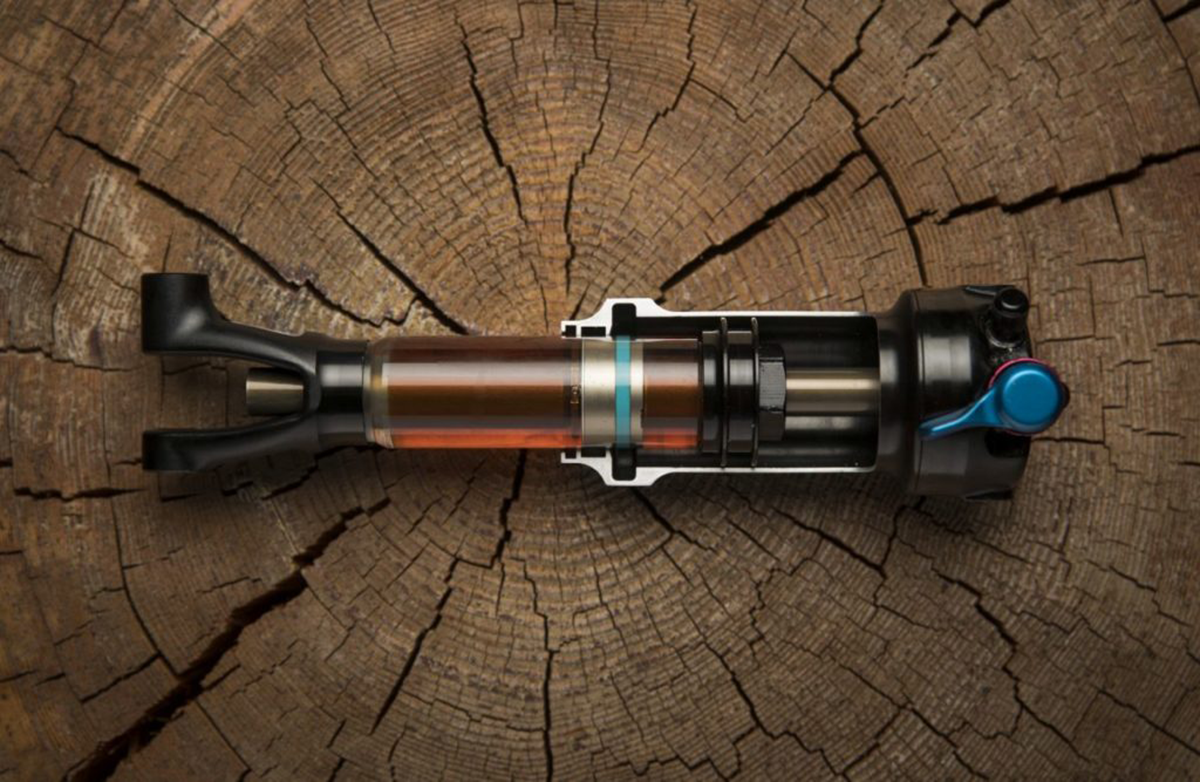
Trek’s engineers drew knowledge garnered from the aerospace industry thru a mold tooling company named Radius Engineering, which ultimately led them to the creation of their proprietary process for building carbon fiber frames, in 1992, which they named OCLV for Optimum Compaction Low Void. Today, 25 years later, Trek still uses the name OCLV for the carbon fiber in its frames.
Birth of the RE:aktiv: Recently, Trek’s engineers drew inspiration from Penske Racing Shocks where shocks are made for Team Penske’s race cars as well as competitor’s vehicles for varied racing/driving formats like Indy, Formula One, NASCAR, motorcycles, dragsters, ATV’s, snowmobiles, and military vehicles. It began in 2015 with Trek’s introduction of the Fuel EX 27.5 mountain bike that featured the product built from their collaboration with Penske Racing Shocks and Fox Racing Shox, a new shock named RE:aktiv.
RE:aktiv was different from other mountain bike shocks in that it utilized a regressive damping system , which Trek claimed would improve climbing efficiency, offer greater speed, increased traction, enhanced cornering, plush responsiveness to large bumps, while offering a firm platform on flats and corners without the lag time encountered in progressive and regressive damping systems that were incorporated by all other manufacturers of mountain bike shocks.
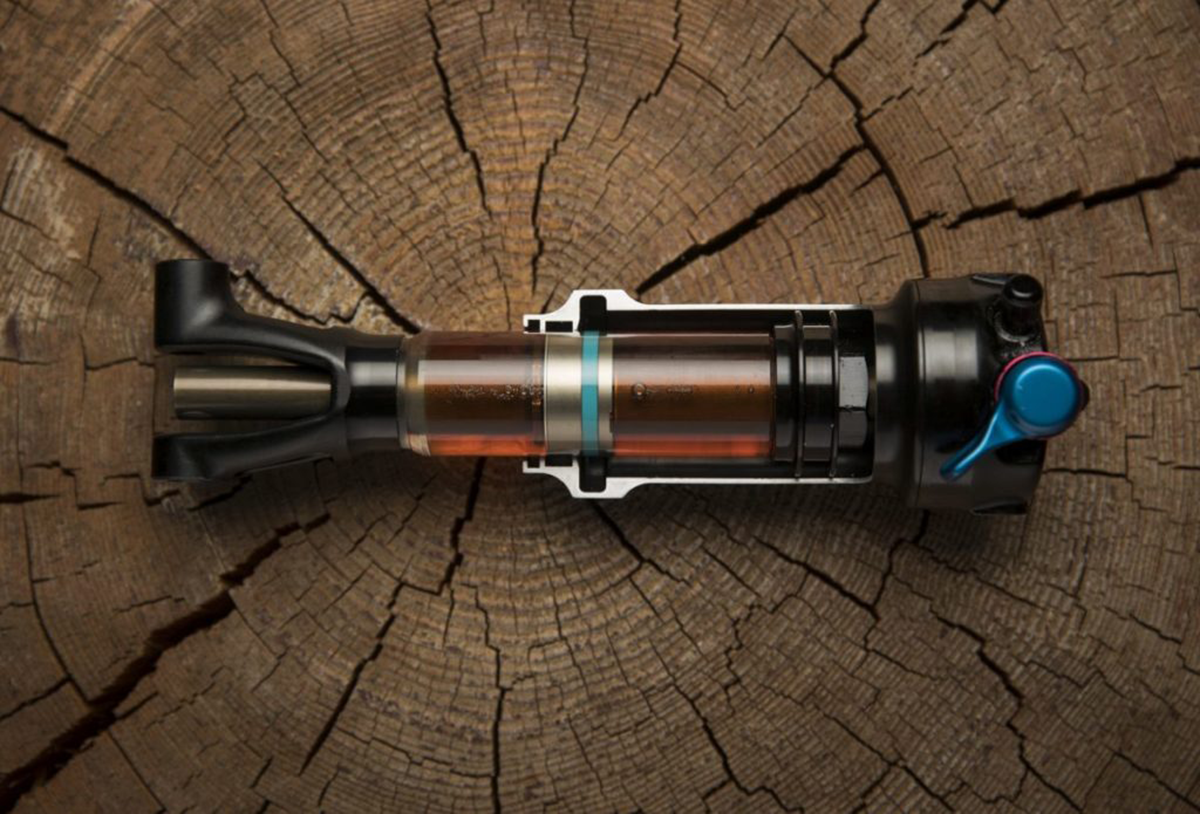
Shock damping systems produce several basic shapes of damping curves that are referred to as progressive, digressive, and linear. A curve is simply a plotted line that is drawn along X and Y axes at various points in order to represent some type of relationship as defined by those axes. Progressive damping systems produce profile curves that stiffen progressively as the velocity (speed of travel in a specific direction) of the suspension increases. For a rider, this means that at slower suspension velocities, the system will be softer, more plush as the rider travels over rocks or other obstacles, while surrendering some control in cornering. However, modification in oil viscosity (Use a thicker oil) in conjunction with closed, or towards the closed range of rebound or compression settings on the shock, will provide enhanced cornering control with some sacrifice on suspension plushness over rocks at lower velocities. In general, and in order to create a more progressive damping curve, the use of lighter oil viscosity, adjusting the compression and rebound settings to reduce valve port size, and crossover shims will help reach that goal.
Oil viscosity affects the compression and rebound characteristics of forks and rear suspension systems. Lighter weight oils increase reaction speeds, while heavier viscosity oils decrease reaction speeds. Rider weight can influence viscosity choice with lighter riders opting for light weight oil and heavier riders selecting higher viscosity oils.
Shims are metal washers that can vary in thickness and diameter that are stacked atop one another against the surface of the damping piston to provide damping force when oil is forced out of a piston’s damping port. The smallest diameter shims are the stiffest, while the larger diameters are less stiff. How shims are selected and stacked seriously impacts the performance of damping because they can control oil flow thru the piston. Increased oil flow provides increased damping effects and vice versa.
Valve ports are manufactured in different sizes along with shim stacks, oil viscosity and pressure in order to control the flow rate of oil into the piston. Port size can be controlled via compression and rebound adjustments on many shocks. Additionally, check valves can be introduced to achieve directional oil flow into the piston with minimal to no oil backlash through the port.
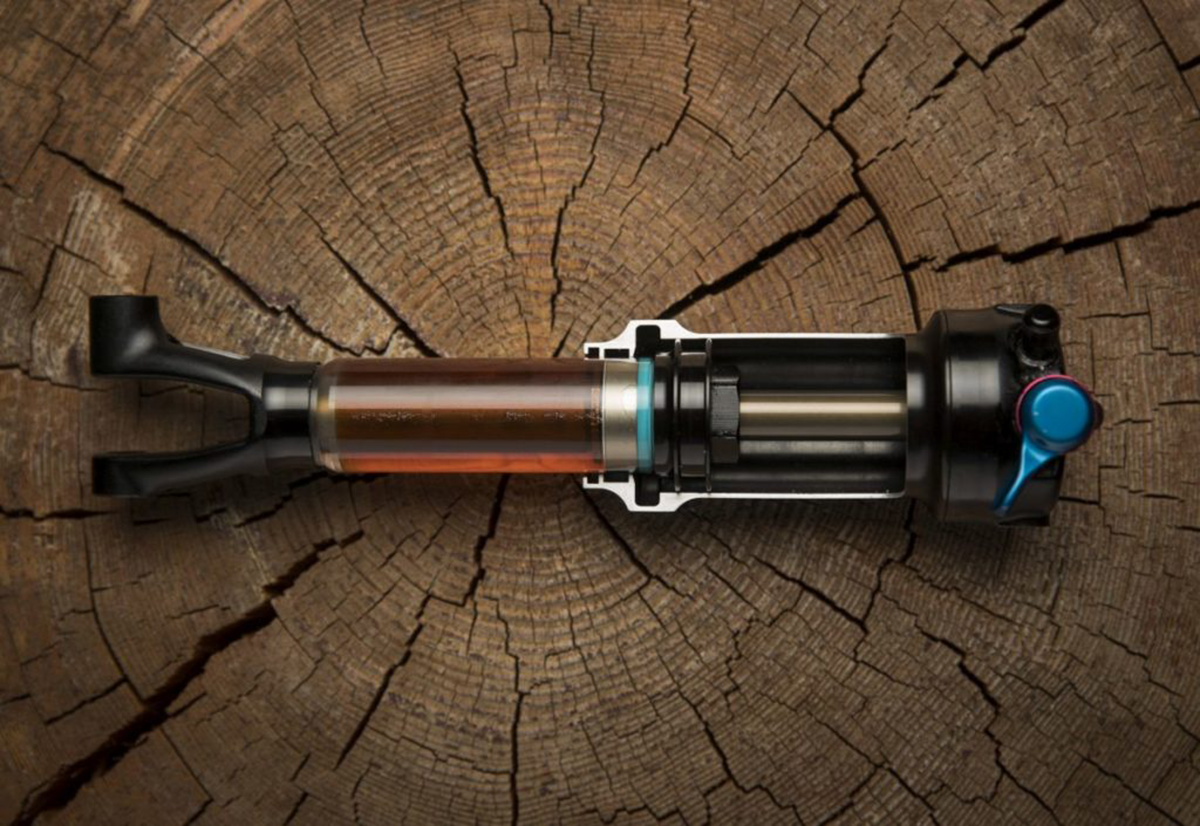
Digressive damping systems produce profile curves that reflect higher damping forces at lower suspension velocities along with decreased damping forces at increased velocities. The higher damping rates at reduced suspension velocities mean that the suspension will quickly stabilize upon exiting a rocky section of a trail and will provided enhanced steering while cornering and lower damping rates at greater suspension velocities that relieve overall stress on the suspension system, which translates into smoother flow over rocks or ruts on the trail. However, the suspension system is now stiffer over smaller rocks/ruts, which can produce a harsher ride, until large enough rocks/ruts are hit and subsequently move the suspension into a plusher, more responsive feel at increased velocities. You can adjust digressive damping by adding or removing shim stack, changing to a higher viscosity oil, use larger valve ports, and by adjusting rebound and compression settings on the shock.
Linear damping systems provide a linear increase in damping force as the suspension velocity increases, while keeping a constant relationship between the suspension’s un-sprung mass momentum and the resultant damping forces. What this means to riders is that if you hit a rock that’s three times the size of the previous one, your impact should be three times larger. A linear relationship relative to suspension will provide a consistent experience across the full stroke of the system. However, other factors are important in developing a linear damping curve/response, and include things like oil viscosity, valve geometry, stack stiffness/taper, compression/rebound indent settings, and crossover shims.
In brief summation, and relative to progressive and digressive damping systems, with progressive systems, the greater the force of impact, the greater the damping effect, while in digressive systems, damping rapidly responds to increased rock/rut sizes, and then levels off.
Trek’s original RE:aktiv suspension system utilized regressive damping, which was patented by Penske Racing Shocks (PRS). In their patent, PRS described regressive damping by stating the following, “One embodiment of the present invention pertains to a damper having regressive characteristics. During extension of the damper at low velocity, the force required to extend the damper progressively increases as the extensive velocity of the damper increases. During operation at moderate extensive velocities, the force required to extend the damper regressively decreases as the velocity increases. At still higher extensive velocities, the damping force progressively increases with increased extensive velocity.” This translates to better handling characteristics regardless of speed of impact therein eliminating the problems inherent in either solely progressive or digressive damping systems such as loss in low speed cornering with progressive systems, or the stiffness experienced with digressive damping. In theory, Trek’s RE:aktiv system will provide better traction and handling along any type of terrain, while also providing superior damping, irrespective of trail profiles.
The refinement of the RE:aktiv for 2017: In 2017, Trek announced that they were introducing an upgraded version of their original RE:aktiv shock, by introducing Thru Shaft technology, which describes a shaft that is attached to both sides of the damper valve so that when the damper valve is pushed thru the oil-filled damper body, the shaft becomes displaced on the other side of the valve. This eliminates oil displacement by keeping the oil volume constant within the damper body. In a traditional air suspension system, a nitrogen gas-charged reservoir lies behind the internal floating piston, which in turn separates the gas-filled chamber from the oil filled chamber. When pressure exerted via the shock’s shaft compresses into the shock’s body, movement of the floating piston from displacement of volume occurs. As the nitrogen is compressed, pressure increases, which prevents the floating piston from exhibiting excessive movement. When the shaft’s pressure is removed, the gas moves the floating piston back into its original position, ready for the next input (bump or rut). This movement in conjunction with the spring returns the shock outwards to its original, pre-activation position.
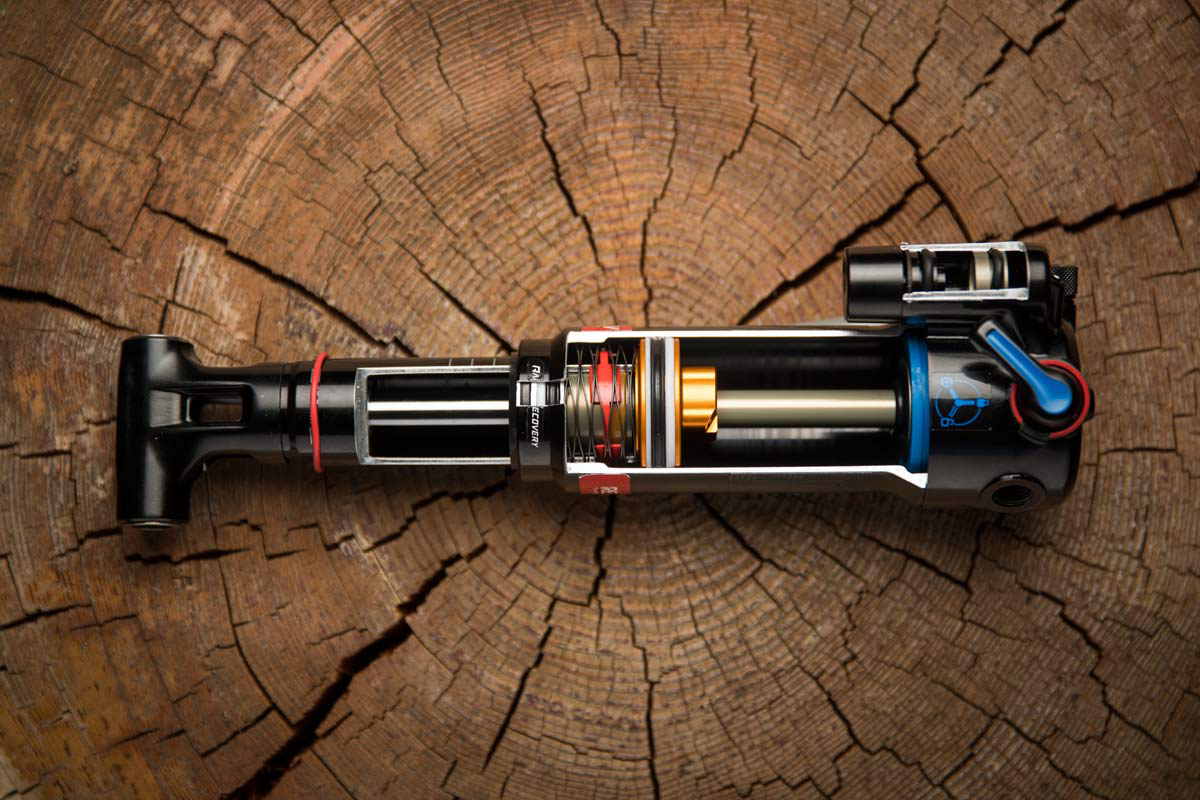
Another important feature of the RE:aktiv Thru Shaft Shock is a simplified construction versus its competitors’ because it not only eliminates oil volume displacement, but has discarded the need for the internal floating piston and the gas-charged reservoir all together . This streamlines the system, which results in decreased hysteresis, which is an ancient Greek word that means “lagging behind.” In bicycle suspension systems, hysteresis refers to the lagging of the effect produced from some input, the cause, that relates to pressure, flow, torque, and displacement in that system. By minimizing hysteresis, product designers can create shocks with predictable responses when subjected to small bumps and big jolts while riding along rocky terrain, in bike parks, or down mountains. By eliminating the gas reservoir and floating piston, stiction produced by the floating piston as it travels along the damper body is eliminated. Stiction, a derivative of static friction, relates to the tendency of an object to stick and slip as a result of high static friction. In suspension system’s valves, this indicates a valve’s inclination to “stick” in the absence of applied forces, and to “slip” when forces are applied. Many things cause stiction including corrosion, oil viscosity, deposition of material, contamination, chemical reactions, and degradation of valve seals. In reducing stiction in the damper body along the shaft’s wall, the shock is quicker to respond to small impacts due to decreased resistance to movement (stiction) and to change direction more readily. In addition, friction produces heat that can impede the smooth functioning of a suspension system. In Trek’s Thru Shock, dissipation of heat occurs when the shock is at rest and the heat can readily dissipate in the surrounding oil, which fills the damper’s chamber. Special material coatings along the shaft wall and on moving components also reduces thermal buildup by decreasing friction.
This isn’t new technology, having been used by other shock manufacturers in the 1990’s but Trek argues that earlier systems weren’t reliable, yet with modern improvements in manufacturing, it’s possible to now produce reliable suspension systems using this technology. Given that from an engineering perspective, the shock is more streamlined, and if properly designed and executed, this shock should provide excellent reliability with a minimum of setup or continuous adjustments. Theoretically, this shock should provide superior responsiveness regardless of terrain. In essence, a suspension shock is designed to allow for tires to optimally retain traction on any terrain, and to provide feedback to riders so they can exercise efficient control over their mountain bikes. Trek’s improved RE:aktiv Thru Shock fills these requirements, which is attested to by its Penske-Fox-Trek pedigree. No mutt intended!
Rumor indicates that Fox and Rockshox have a 2-year exclusive marketing agreement with Trek for Trek’s sole usage. However, after that timeframe has elapsed, more manufacturers may jump on the bandwagon and produce regressive-type suspension systems. Ultimately, mass rider experience, input, and feedback will determine the success or failure of this newly reinvented system. After all the physics, beautiful charts, and marketing hype have faded, rider experience will determine the final verdict, which will be based solely on handling performance, reliability, adjustment ease, and durability. I wouldn’t bet against Penske, Trek, or Fox, if I was a gambling man.
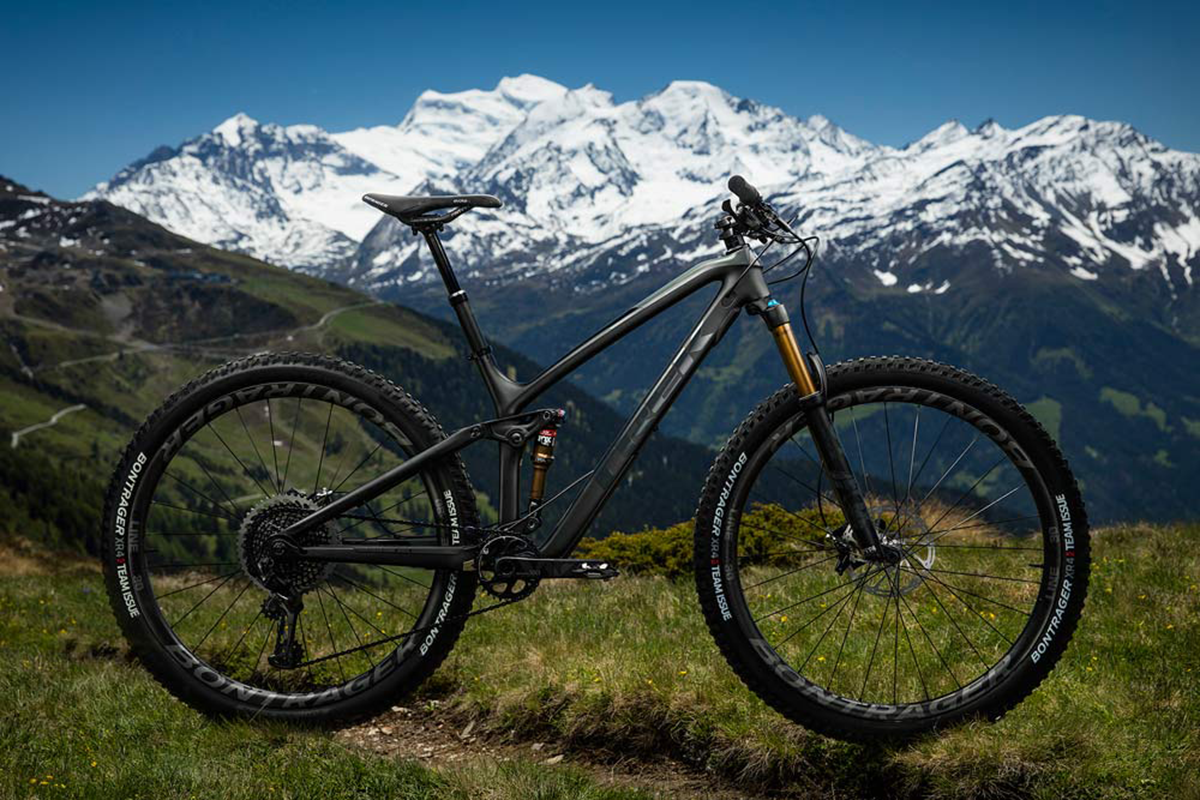
August 01, 2017
Rear Shock › Suspension › Trek ›
Top Products For You...
Recent blogs.
- RaceFace Era & Turbine Handlebars - Tuned Compliance for Every Rider
- Fox Forks For 2025 - All New Dampers To Better Match Your Shocks
- SRAM Apex Shift/Brake Lever [Rider Review]
- OneUp Thick Grip [Rider Review]
- Tire Wisdom 2.0, Nifty New Products, Bike Versatility & More... Ep. 133 [Podcast]
--- Shop Info ---
- Videos / Blog Articles
- Contact / Locations
- Demo Bike Program
- Custom Bike Builds
- Miles For NICA
- We're Hiring!
- Affiliate Program
- Accessibility Statement
- Refund Policy
- Terms of Service
- Privacy Policy
--- Stay In Touch ---
Newsletter signup -.
© 2024 Worldwide Cyclery

First Look: Trek RE:aktiv Thru Shaft Shock
Trek introduces thru-shaft technology for better shock performance and traction
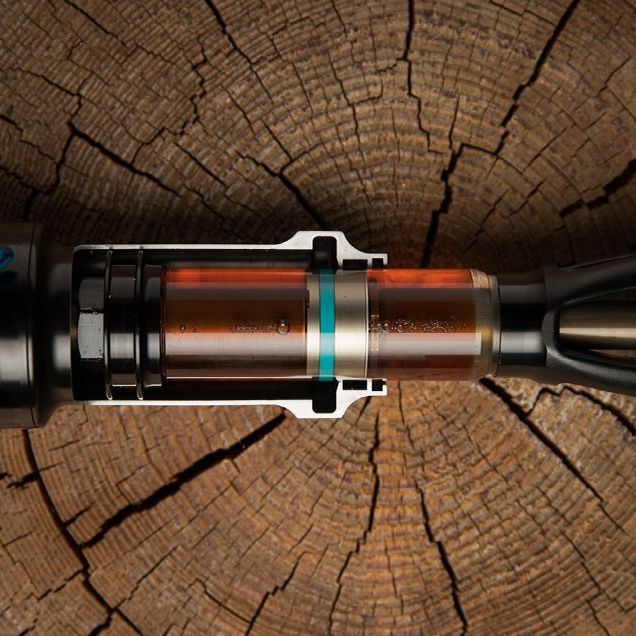
Trek is casting aside the internal floating piston (IFP) damper design found in almost all shocks used by full suspension mountain bikes , and using a thru-shaft damper design instead. Thru-shaft is exactly what it sounds like: the damper body is skewered by a continuous damper shaft (picture a hot dog that’s longer than the bun).
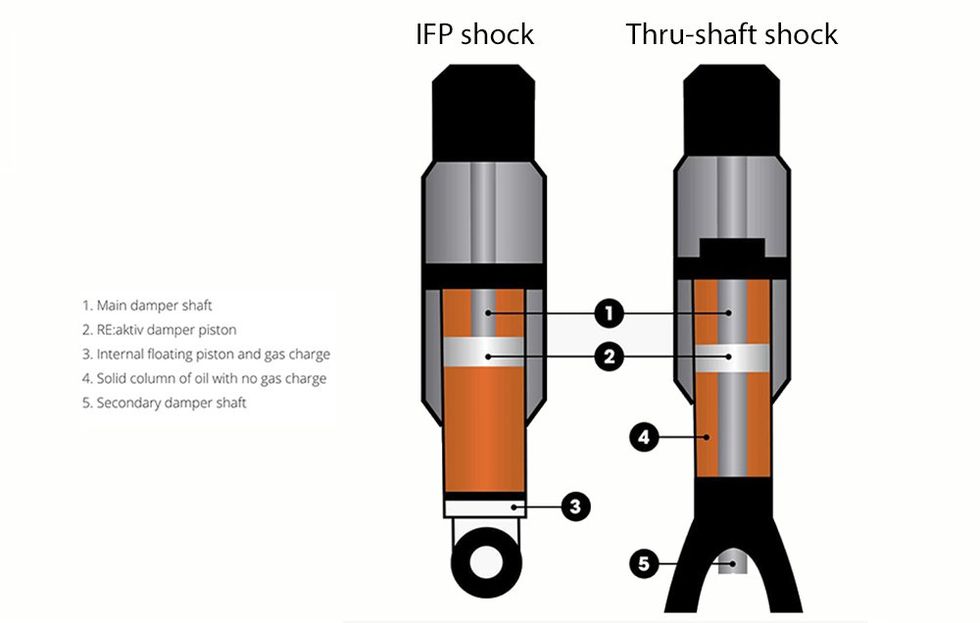
An IFP design, in contrast, is capped on one end: the damper shaft enters one end, but does not continue through the damper body. The IFP resides at the capped end of the damper body: on one side of the IFP is oil, on the other is empty space filled pressurized gas (usually nitrogen). As the damper shaft enters the body during the compression stroke, it displaces oil causing the IFP to move into the pressurized space. When the shock rebounds, the IFP slides back to its original position.
A major advantages of the thru-shaft design, Trek representatives claim, is reduced friction. Every time the IFP stops and changes direction there is a momentary sticking that is felt as harshness in the suspension and causes a lag in the movement.
Another advantage is more-balanced oil pressure. According to Trek representatives, in a IFP design, the oil is under pressure from the IFP, and whenever the valves that control damping open to flow oil there is also a momentary pressure equalization on each side of the piston that also contributes to delays and inconsistencies in damping forces. Thru-shaft is claimed to greatly reduces the pressure differences on each side of the shock’s main piston, resulting in improved sensitivity.
Every shock needs to be properly adjusted for your weight. Here's how:
Thru-shaft is not without its drawbacks. The Rockshox Thru-shaft shock on the Remedy with all mounting hardware weighs 531 grams - that's 57 grams heavier than the standard Rockshox Deluxe shock on the 2017 model. In theory, the addition of another oil seal where the shaft exits the body is another place to leak, and it's another seal exposed to dirt.
RELATED: First Look: RockShox Super Deluxe Coil
Thru-shaft isn’t new technology. Thru-shaft is currently used in Moto GP, Indy, Lemans and F1 racing. Many years ago, thru-shafts were used in various mountain bike suspension applications with the most popular being Rockshox Judy forks of the mid 90’s.
Decades ago, I personally replaced countless Judy thru-shaft fork cartridges. The cartridges were notoriously unreliable, and failed with regularity because of materials and thermal issues. Trek’s RE:acktiv thru-shaft shocks, however, are made from quality materials and have thermal compensation systems, and so should be more durable than the infamous Judy cartridges.
RELATED: The Most Exciting 2017 Mountain Bikes at Sea Otter
Trek will use RE:active thru-shaft shocks made by both FOX and RockShox. There are no patents on thru-shaft technology but Trek has a two year exclusivity agreement with FOX and RockShox, so you won’t see another manufacturer adopt this technology until at least model year 2020.
Trek is utilizing FOX RE:aktiv Thru-shaft shocks on its shorter travel bikes and RockShox RE:aktiv Thru-shaft shocks on its longer travel models. Trek’s 2018 bikes with RE:aktiv Thru-shaft shocks include the Slash 9.8, Slash 9.7, Remedy 9.8, Remedy 9.8 Women’s and Fuel EX 9.9, as well as carbon framesets . The thru-shaft equipped models will hit shops this August.
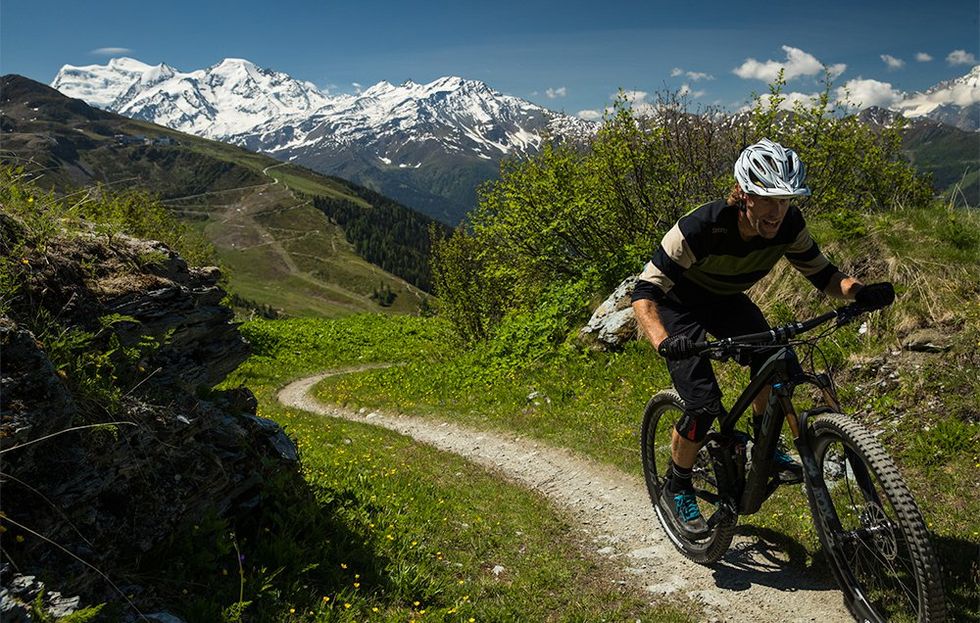
My first experience with RE:aktiv Thru-shaft was aboard a Trek Fuel EX in the Swiss Alps . I had just ridden the Editor’s Choice winning 2017 version of this bike a few months before so I was somewhat familiar with it. But it was immediately apparent that the thru-shaft shock performed differently. It felt smoother and more eager to move than I remember, so I moved the shock’s compression lever into the middle setting for the smooth climb that began our ride. This provided a firm support for pedaling, but still moved when I climbed over roots and steps. I initially thought my pressure would be too low for the descent, but it wasn’t the case. Descending a fairly steep bike park trail, I noted how well the rear end tracked, and only felt it lightly bottom on a hard, flat, landing.
RELATED: Tested: Trek Fue EX 9.9 29
That first ride revealed a better shock, but I really wanted to know exactly where and how so I took advantage of having Trek’s suspension development center only 30 minutes from my house and arranged a test day with Jose Gonzalez, Trek’s Director of Suspension Design. He brought a Remedy with the 2017 shock, and the new thru-shaft version so I could do an A-B-A test: I would start with the old shock, then ride the new, then switch back to the old. The trail I selected for testing I know very well, having tested countless mountain bikes there over the last 16 years. It offers a bit of everything, and allows for quick shuttles, making it perfect for this sort of testing.
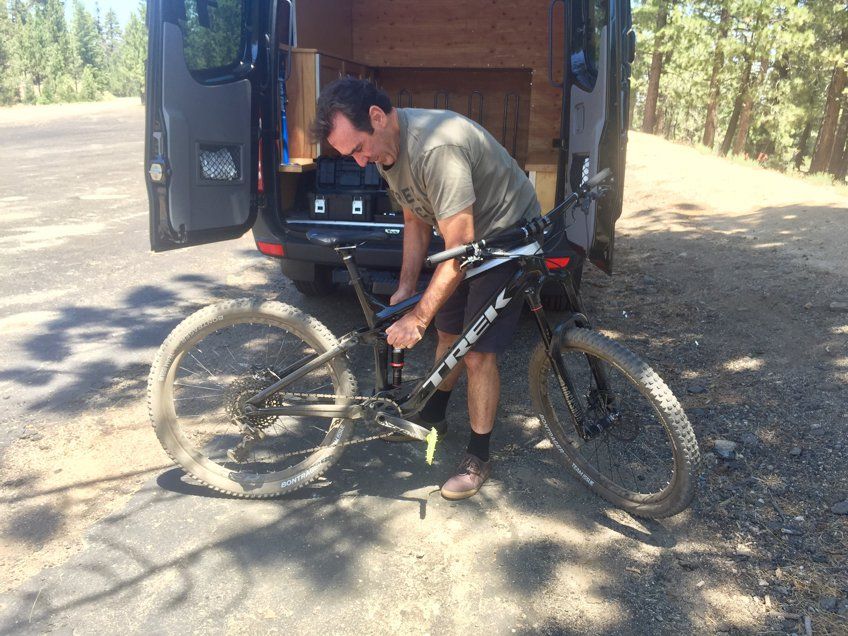
After taking a handful of runs on the 2017 shock to dial in the bike, we swapped in the RE:aktiv thru-shaft version. Sag was once again set at 30 percent, but it took 10 PSI more to achieve the same number because the IFP in the old shock adds some spring effect.
Like in Switzerland I immediately felt a difference, but this time I could really pinpoint where. Large hits feel identical between the two shocks, but small to mid sized hits–such as sharp square edges and braking bumps–were taken much more smoothly . The bike also had a more planted, predictable feel.
RELATED: 8 Awesome Pieces of Women's Mountain Bike Apparel
The change to the rear end’s performance was dramatic enough that the Lyrik fork, which had felt dialed, now felt harsh, prompting me to remove a few PSI for the next run. With the bike now balanced and dialed in, I fired off a few laps, enjoying the ability to push the bike harder and corner with seemingly improved traction.
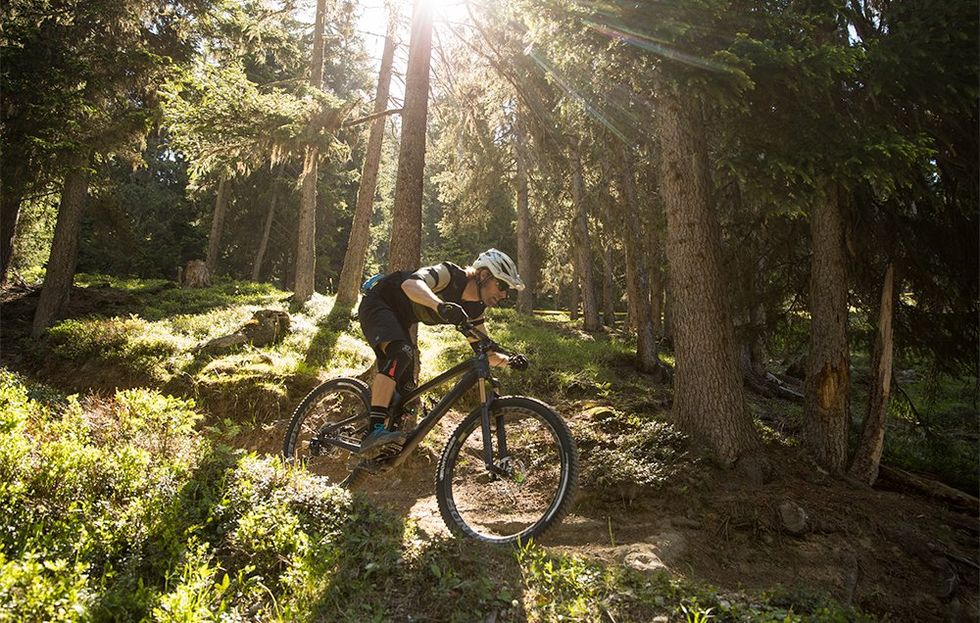
For the final set of runs, the , RE:aktiv thru-shaft shock was replaced with Trek’s 2017 shock (it’s often easier to feel something that’s worse than to feel something that’s better). I was immediately noticed harshness on small bumps and I even got kicked on a few lippy jumps where the RE:aktiv thru-shaft flew straight and even. I can’t speak for every model or shock, but on this bike, and with these shocks, the RE:aktiv thru-shaft version was clearly superior. I will continue to ride the bike and shocks for more long-term testing so stay tuned for more on this bike and others with this exciting new thru-shaft technology.
.css-1t6om3g:before{width:1.75rem;height:1.75rem;margin:0 0.625rem -0.125rem 0;content:'';display:inline-block;-webkit-background-size:1.25rem;background-size:1.25rem;background-color:#F8D811;color:#000;background-repeat:no-repeat;-webkit-background-position:center;background-position:center;}.loaded .css-1t6om3g:before{background-image:url(/_assets/design-tokens/bicycling/static/images/chevron-design-element.c42d609.svg);} Bike Reviews

The Best Beach Cruisers for Leisurely Rides

The Best Hardtail Mountain Bikes

Best Hybrid Bikes You Can Buy Right Now

The 14 Best Road Bikes of 2024

The Best Commuter Bikes for Getting Around Town
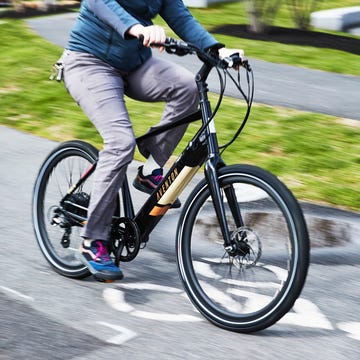
The 10 Best Electric Bikes, Tested by Our Editors
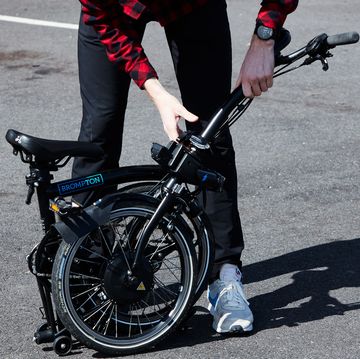
These Folding Bikes Can Go Everywhere

Smoother and Faster: The New Pivot Switchblade

The Best Beginner Mountain Bikes

Reviewed: Colnago's Italian Made C68 Gravel
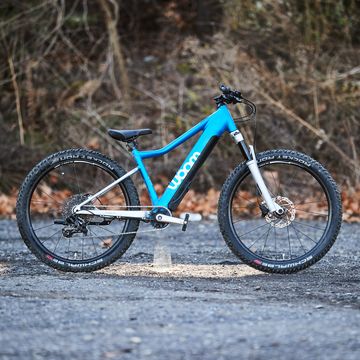
The 6 Best Kids’ Bikes in 2024
Trek Unveils Fuel EX 27.5, Partners with Fox and Penske for RE:aktiv Shock
- Click to share on Facebook (Opens in new window)
- Click to email a link to a friend (Opens in new window)

They say good things come to those who wait, and in the case of Trek’s latest suspension project with Penske Racing Shocks, the new RE:aktiv rear shock is the product of 5 years of research and development. Offered on the brand new 27.5″ platform of the venerable Fuel EX, the RE:aktiv shock builds on Fox’s DRCV technology to offer a new level of suspension performance.
Already a leader in the custom shock absorber market for high performance vehicles such as Indy Car and Formula 1, Penske does not offer mass produced suspension. Instead they custom tailor each part to the needs of their customers and teams. A chance meeting between Trek’s Dylan Howes, the director of Trek’s MTB frame technology, and Jim Arentz, Penske Racing Shocks’ Technical director, led to the idea of a partnership to include Penske’s technology in Trek’s latest bike. Five years later, the new Trek Fuel EX 27.5 is ready for its debut, F1 technology and all…
The biggest difference that sets the RE:aktiv shock apart from the pack is the inclusion of what Trek and Penske refer to as regressive damping. Most mountain bike suspension is either progressive or digressive, while regressive damping is supposedly true F1 technology that has trickled down to Indy car, NASCAR, and now, well mountain bikes. On the track, regressive damping provides firm support on the straights and corners but as soon as it encounters a bump, the shock instantly opens up to plush, smooth progression. This all happens extremely fast and as Trek points out, “delivers on the unrealized potential of an inertia valve.”
Once Trek and Penske had worked out the damping they wanted to incorporate into the RE:aktiv shock, Fox was brought in to package it into a patent-pending exclusive design only for Trek bikes.
“The thing about Penske is they’re completely focused on being a racing company. So what we’re doing is leveraging their R&D resources and turning that into almost an extension of our own capabilities,” said Trek Director of Suspension Development Jose Gonzalez. “The combined effort with Fox providing the production expertise has produced just an outstanding shock.”
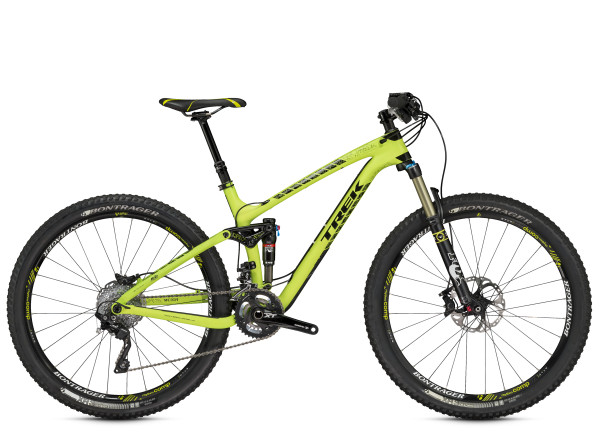
As for the bike itself, the 27.5″ Fuel EX continues where the other Fuels have left off. In addition to the RE:aktiv DRCV rear shock, the frame includes Trek’s ABP (active braking pivot) and Full Floater suspension linkage with both OCLV carbon and aluminum frame options. Suspension is dialed in for 120mm of travel front and rear which mates to a 68 degree head angle and 73 degree seat tube angle. Other important numbers include a 142×12 rear end, ISCG 05 mounts, BB95 bottom bracket (carbon model), internal derailleur and dropper post routing, and E2 tapered head tube.
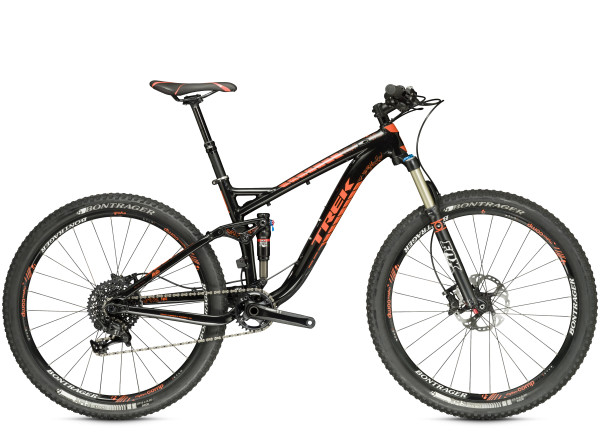
As of the launch, the 27.5″ Fuels will be offered in one carbon version – the EX 9.8 (with alloy chainstays), and three aluminum versions – the 7, 8, and 9. Pricing starts with the EX 7 27.5 at $2,629.99, up to the $5,249.99 Fuel EX 9.8 27.5. If you’re looking for the RE:aktiv shock technology however, you will only find it on the EX 9 and EX 9.8, the 7 and 8 models stick with the standard Fox DRCV technology.
Sold in the same sizes as the Fuel EX 29 with the exception of the 23″ frame, select models are available now from Trek retailers with the rest of the line available later this Summer.
trekbikes.com
Zach Overholt is the Editor in Chief of Bikerumor . He has been writing about what’s new in the bicycle world for 12+ years. Prior to that, Zach spent many years in the back of a bicycle shop building and repairing nearly every type of bike, while figuring out how to (occasionally) ride them.
Based in Ohio, Zach is now slowly introducing a new generation to cycling and still trying to figure out how to fit the most rides into a busy schedule as a new dad.
This site uses Akismet to reduce spam. Learn how your comment data is processed .
There is second carbon on trek’s website. The 9.9. http://www.trekbikes.com/us/en/bikes/mountain/singletrack_trail/fuel_ex/fuel_ex_9_9_27/#
ok so why do they have to write “reactive” that way ? Cool bike anyway,it’ll give Specialized’s Brain a bit of a run. I wish I could try one.
“On the track, regressive damping provides firm support on the straights and corners but as soon as it encounters a bump, the shock instantly opens up to plush, smooth progression. This all happens extremely fast and as Trek points out, “delivers on the unrealized potential of an inertia valve.”
….so it’s a new version of the Brain?
The other carbon on the website is just a computer generated pic. If the 9.9 looks like that they should be shot
Eric, looking at some other Penske products, it just seems to be a valve and shim stack.
Sounds like Trek is criticizing Brain and other inertia valve systems.
“On the track, regressive damping provides firm support on the straights and corners but as soon as it encounters a bump, the shock instantly opens up to plush, smooth progression. ”
without exception, that’s what the ad copy for every bike suspension product ever made has said.
The last time Penske raced F1 was the late 70’s with only one victory in ’76
Just hope for small bumps and chatters compliance
@aaron – you are correct in that Team Penske/Penske Racing only raced F1 in the 70’s, however Penske Racing Shocks is currently a shock supplier to several current F1 teams.
Inciting gun violence against those who design bicycles seems quite smart :/
I see a new market of lower travel bikes (120-130mm of travel), but with geometry that lets you jump/drop and corner like a crazy person(low BB and 67 degree head angles) sparked by bikes like the Kona Process 111(w/29), Santa Cruz 5010, etc. I’m doing my own version by throwing a 1.5 degree angleset in my new Blur TrC and putting a lowered Pike on it.
yeah I can really see how F1 cars and mountain bikes share the same suspension needs.
also congratulations trek on your late entry onto the hi-ves yellow bandwagon
I can see how suspension knowledge can be utilized across different platforms.
@ron – 4X bikes
Shout out to Verizon!
all ready done, 2009 trek fuel with works components -2º head set, off set shock bushings from burgtech, fork lengengthened an extra 10mm and bigger from tyre than the back i’ve takene the stock 71º head angle to a measured 67º and a BB bang on 13” :o) had to fit an non setback seat post to maintain a usable climbing angle. 165 26-38 xt crankset help with peddle strikes but are tough with my 11-28 cassette. filed the fork damper with 12.5 wt and it’s like a new bike, super stable even when landing off the side of the trail it just keeps tracking where i want it.
@Padrote – Pretty much any form of vehicle racing requires suspension to do basically the same thing – keep the chassis stable and provide adequate traction and feedback to the rider/driver during low-speed events like braking, cornering, and accelerating while still being able to respond to high-speed events like an F1 car hitting a curb, or a MTB hitting a rock. F1 is at the pinnacle of racing, so why not use a technology/design that works in that application?
Yes Trek, please top trying to progress our equipment so that we can stay with the status quo!?!?
I know this must seem crazy, but maybe we should all wait to ride these bikes before giving an opinion?
Le histoire se repete. Didn’t Paul Tracy ride a Penske suspended thermoplastic Yeti somewhere in the early nineties? Nice to see Trek is working with them now.
“Boost148” hub spacing. Oh my.
http://spokemagazine.com/2014/06/11/trek-release-new-rear-suspension-platform-and-carbon-remedy/
Like all 27.5″ flagship bikes from big brands, this one also features the “tennis ball” color in an attempt to make you think it’s as cool as the SantaCruz Bronson…
The RE:activ shock can also be found on the EX 9.9, whose existence on this mortal plane as of right now is awaiting the delivery of the new XTR 11 speed components.
Ah the old F1 tie in
I worked in F1 iirc at this moment in time caterham are running penske shocks
depends what and where you read it but it initially sounds very inerter like in its description of function though very doubtful it is anything like that n reality however as far as brain shocks go that would be next evolution before MR fluids and penske were involved from around 2008 with inerters
So how is this thing any different to an air version of the 5th Element shock?
I had a chance to ride the carbon version over the weekend at a Trek demo day in Bellingham. Although the sizing was wrong, I found it to be an awesome bike. I had no idea about the new shock, but felt that it was XC efficient while climbing, yet felt very plush and controlled on the way down. I also demoed a Fuel ex 29er and didn’t get along with it as well. The 27.5 bike was noticeably slacker and more playful. That neon green color is even more shocking in person. Despite that, I’d strongly consider getting one once they come out with a carbon 1 x 11 version.
“Inspired by a Kona process”…. That design was outdated 10 years a go. Good to see all the big company lame a** bashers on bikerumor comment befor they’ve ridden it. Why even come to this site if you hate EVERTHING new? (deleted) Some of us come here to see ACTUAL new info, embrace new technology and, if you pull your head out of your a** realize this is probably a pretty damn cool bike no matter who’s logo is on the side. Kudos to Trek for actually researching and designing instead of ripping off and duplicating. Except the color of course, why would anyone paint a new bike in a popular color. That’s crazy talk.
Right on Dee Sanchez, right on!
I love bike Porn!
I’m currently riding a 2011 Fuel Ex 9.9 which I couldn’t see any reason to upgrade in the near future, but this has made me rethink, TREK’s decision to drop 26″ Fuel Exs from their range shows commitment and confidence in the new wheel size. I’m heading to TREK World at the start of August, hopefully I’ll get a chance to spend some time on one of these.
For those saying they copied the colour of the Bronson, well, the bike is actually quite green, not tennis-ball yellow at all.
Come on, Stop all the Trek bashing guys. Most of you would ride the fool out of this bike if you actually gave it a chance. No Trek is never going to be the niche brand that only the cool kids ride, but as a guy that sells multiple brands, they put a hell of a lot more R/D in their bikes than most other brands.
IE. You are not Cool just because you think your bike is the coolest. Don’t be a “Joey” from the how to be a mountain biker video.
this has nothing to do with an inerter. inerter only belongs in f1, or any other vehicle that uses extremely high spring rates coupled with extremely tall, soft tires. 5th element shocks, and all that followed, have been some form of digressive damping. at low shaft speeds, damping is relatively heavy, getting heavier with faster shaft speeds roughly linearly… until you cross a threshold, in which the damping force increases with shaft speed at a much slower, still roughly linear rate. digressive damping still has a faster shaft speed equaling higher damping force, no matter what. regressive damping (and inertia valve shocks) do what others cant: past a certain shaft speed, the damping force is LESS than at slower shaft speeds. funny thing, and im not suggesting we use it, but you know what kind of damping is regressive and dirt cheap? friction damping.
No, it’s not a “BRAIN.” It had a hell of a lot more research than that.
Boost 148? Ridiculous. I hope this falls flat on its face.
Handling and comfort would be a lot better if the industry demanded that riders adapt to plush, working suspension, rather than reinforce the misconception that crappy small-bump compliance = efficiency. But, you can’t give people what they need; you have to give them what they think they want.
@’Ol ‘Shel – RE:aktiv/regressive damping does NOT necessarily hinder small-bump compliance. Small bumps still create high velocities, which is where the regressive damper ‘opens up’ and lets the suspension move.
Hmm. I have ridden a few epics and the brain is not for me. The klunky on off feel is a major turn off. Since the Brains introduction, it has been redesigned a million times. Im not even sure Specialized believes in it yet.
I look forward to riding Treks version. Its a great concept, excited to see the execution.
since specialized revised the fundamentals of the brain action in 2009, it’s been fantastic. completely unobrrusive. old ones had the brass mass as a hydraulic timer, staying open for a defined time after first hit. 2009 on the circuit closes upon rebound every time. it took specialized to notice what fox overlooked- the fact that for the second hit, the circuit would reopen before the shock was even done rebounding. no need for the timer.
Trek’s website lists a crazy high stack height on the 17.5″ model for some reason.
120mm is weak vs. the Santa Cruz Solo 130mm with similar geo. And alloy chainstays vs carbon on the Solo. Fixed Trek build kits with choices you don’t want vs many choices on the Solo. And coming out like a year later.
But they have a new proprietary shock! Not gonna get excited just yet.
its still a trek.
wow..you haters should ride one..I rode one at a trek demo and was blown away by the new shock(I already have a 29er Fuel EX and love it) ReActiv hooks up almost like the rear end is locked out. I will say that I lock out my rear shock with a remote on most climbs anyway, but this technology is a spot on upgrade to what has existed until now….I call the 27.5 wheel “cute” because 29ers roll better anywhere! but thats been settled(or argued to death)…this bike is a winner and I’m sure we’ll see ReActiv in the 6 inch bike next year which will be one hell of an all around “trail” bike.
Follow Us On
Subscribe Now
Sign up to receive BikeRumor content direct to your inbox.
- Pinkbike.com
- Register New User
- First Looks
- Friday Fails
- Community Blogs
- Fantasy League DH
- Places Directory
Trek Debuts New RE:aktiv Thru Shaft Shock Technology
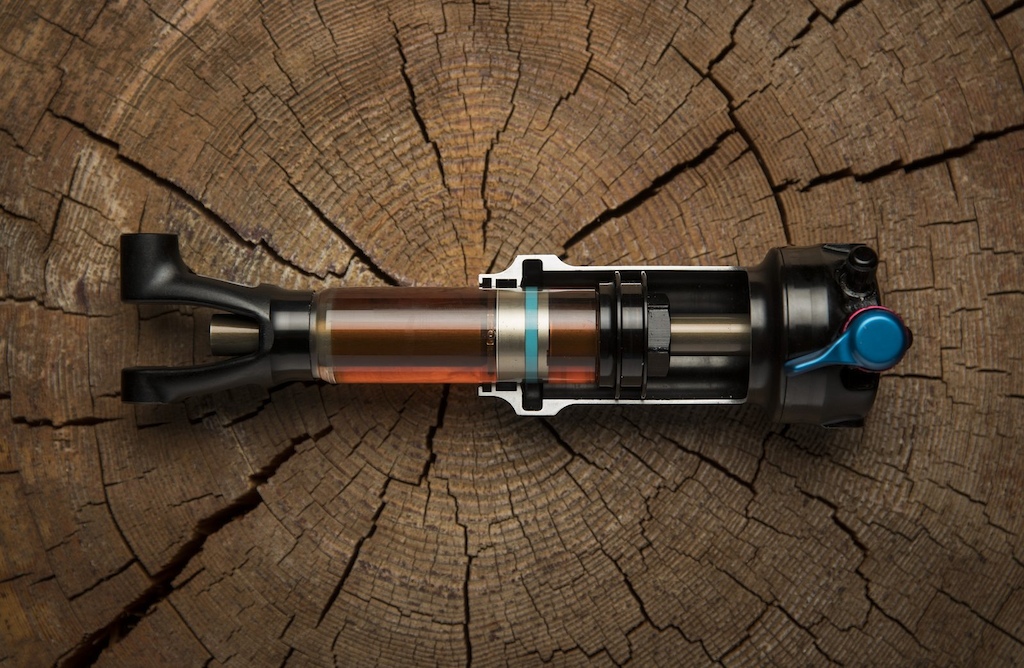
Cool Features

Trek Shocks
New for 2018:
Maintenance Info:
Volume Spacer Information:
*TREK Thru-Shaft Shocks can fit up to the 0.8in^3 DPX2 volume spacer
Assembly Drawings
Common sub-assemblies.

Assembly Drawing: Trek Thru-Shaft .

806-29-427-KIT Sleeve Assembly: 2018 Float Evol LV [3.764 TLG] Kashima, 210 x 52.5, Trek TSS

806-61-200-KIT Body Assembly: Trek TSS, [.940 Bore, 3.735 TLG], 210 x 52.5, Kashima

805-00-102-KIT Piston Assembly: Floating, with Bleed, Trek TSS


808-17-327-KIT Eyelet Assy: 2017, Trek TSS, Reaktiv, LV, Trunnion

812-06-084-KIT Bearing Assy: Trek TSS

TREK TSS Valving Assemblies CM, RM, RaM .

815-72-005-KIT Valving Sub Assy: Trek TSS, Reaktiv Valve Housing, CM, RM

815-72-004-KIT Valving Sub Assy: Trek TSS, Reaktiv Valve Housing Cap

Slave Shaft Assemblies, TREK TSS .

Distributor and OEM service documents access
CORPORATE SOCIAL RESPONSIBILITY
Buy suspension, shop apparel, technical help center.
- About Our Authors
- SRAS: Study Abroad or Online
- GeoHistory: Geopolitics, History, News
- PopKult: Popular Culture
- Museum Studies: Museum Science, High Culture, City Planning
- Students Abroad: Travel Guides

Popular articles
- May 27, 2017 | Home and Abroad with RSL in Bishkek and Irkutsk
- May 17, 2014 | 10 Differences Between Moscow and Saint Petersburg
Moscow Vs. St. Petersburg - which to chose?
10 Differences Between Moscow and Saint Petersburg
Published: May 17, 2014
I recently returned from a trip to Moscow, included as part of my study abroad program in St. Petersburg , and have been inspired to write a comparison of Russia’s two biggest cities! As a disclaimer, I have visited Moscow twice, for a total of 6 days and visited St. Petersburg 4 times, (and it is where I currently live) for a total of 6 months. Clearly, I have had more time to form an opinion of St. Petersburg, but I believe that from my experiences, along with input I’ve gathered from people who live, work, and study in both cities, I have managed to come to a balanced conclusion.
Many people opined that Moscow is flashier than Petersburg, and when it comes to going out on the town, I agree. For everyday street wear, though, I saw a big difference in women’s attire. In Moscow you are much more likely to see jeans, whereas in Petersburg skirts and tights are more common. Moscow women more frequently wear tennis shoes (including the high-heel version) and Petersburg women are almost always in heels – from the women walking into the ritzy bridal salon on Nevsky to the woman working behind the counter at the post office. In this respect, Petersburg is more posh to Moscow’s shock-and-awe glitz and trend following.

*In general, Russian women dress up much more than their American counterparts. Every occasion outside the home from grocery shopping to picking the kids up from school calls for a carefully crafted look from head to toe. Russians are not at all lazy dressers and most wouldn’t be caught dead in public in sweatpants or without makeup.
Architecture
This is a big factor that anyone would notice! Saint Petersburg is chock full of palaces, classical architecture, and pastel colors. While both cities are full of less-than-appealing Soviet concrete apartment blocks, Moscow features more Soviet architecture as focal points (such as the Seven Sisters). Both cities have many gorgeous cathedrals, but Moscow is more dominated by the “typical” onion-dome look. Saint Petersburg also does not have as much modern architecture as in Moscow, whose financial district is a chunk of glassy skyscrapers, the likes of which are not to be found in the Venice of the North. Moscow’s former mayor, Luzhkov, had a particular liking for modern architecture and from about 1990-2010, there was no solid policy on what to build where and developers ran wild, helping create the eclectic Moscow of today. St. Petersburg has always been more homogeneous and better preserved.

In a similar vein to architecture, city layout is different between the two cities. This one is pretty easy to spot with just a map. Moscow, as is common with medieval cities that used to be confined by city walls, is dominated by rings and, particularly in the center, by narrow, winding streets. Saint Petersburg, which was purposefully designed from scratch after the advent of civil engineering, has a more grid-like pattern, heavily incorporating the rivers and canals that Peter the Great intended his subjects to use as their primary mode of transportation. Moscow feels more open, and there are more vantage points to the city (mainly in the center), where in Petersburg it’s easy to feel slightly boxed in by the long rows of imperial facades. Moscow is more confusing for a newcomer, however, with the feeling of constantly moving in circles, while Petersburg has a simpler, more navigable layout.

Cleanliness
Petersburg is cleaner on the whole, with air currents circulate fresh air in from the sea, unlike in Moscow. Of course, there is definitely litter in both cities, but more trash can be seen on the street in Moscow which is also a bit dingier in parts.
A huge aspect that nearly everyone mentions when asked is that the pace of life in Moscow is faster. In Petersburg, people are less pushy and will stop and smell the roses, while in Moscow, everything is important and urgent and everyone walks at lightning speed. Probably the largest contributing factor to this is each city’s population size with Saint Petersburg at around 5 million and Moscow around 12. I can’t say that I experienced this much myself, in fact I think both cities moved very and equally fast, but for the frequency of this response I received I have to include it.
About the author
Samantha guthrie.
Samantha Guthrie attends the University of Virginia, class of 2016. She is a double major in Foreign Affairs and Russian and Eastern European Studies. A Boren Scholarship recipient, she plans to work for the US government in a career related to national defense intelligence or international aid. Her research focuses on the relationship between Russians and Caucasians. She spent spring and summer 2014 in St. Petersburg with SRAS Russian Studies Abroad and Russian as a Second Language.
Program attended: Challenge Grants: Funding for Study Abroad
View all posts by: Samantha Guthrie
Russia Travel Blog | All about Russia in English
- About our blog
- RussiaTrek.org
Sidebar →
- Architecture
- Entertainment
- RussiaTrek.org News

- Send us a tip with a message
- Support RussiaTrek.org
- Travel Guide to Ukraine
- Comments RSS
← Sidebar
Transpolar Railway – The Dead Railroad
1 Comment · Posted by Sergei Rzhevsky in History , Photos , Regions
Transpolar railway (Gulag construction sites #501 and #503) is a railroad running on the way Chum – Salekhard – Igarka.
The construction of the railway began in 1947. Among the most likely reasons of the construction were the developing of infrastructure of Russian North, the simplification of supply of Norilsk, as well as improving the supply of the Northern Fleet.
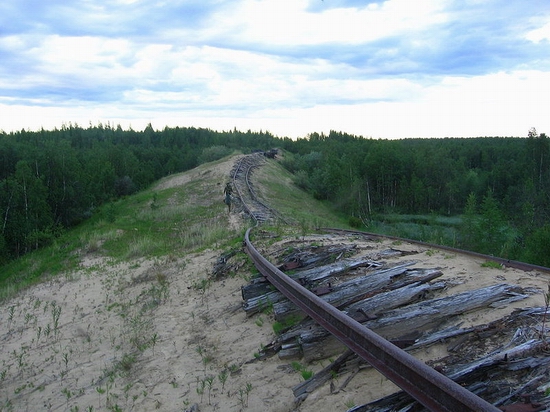
By the end of 1949, the number of prisoners who worked in construction was about 70,000 people. Along the route every 5-7 kilometers there were camps with 500 to 1,500 inmates – about half of them were convicted on political charges.

The entire route of the railway took place in the Arctic. Camp regime and harsh climatic conditions – thawed swamp, mosquitoes and midges in the summer and snow drifts and temperatures down to 50 degrees in the winter – made the life and work of prisoners particularly hard. But Soviet leaders urged the construction of the railway and the prisoners were building up to 15 kilometers of railroad per month.

In March 1953, after Stalin’s death, an amnesty was granted and most of the prisoners were released. March 25, 1953 Soviet Government decided to suspend the construction of the railroad. The last prisoners left these places in 1955.

The constructed sections of the railway were abandoned. There is no official data on the number of deaths in construction. Rough estimate ranges from 60,000 to 100,000 for the period of 1947-1953. That’s why this railway is also called the Dead Railroad.

Tags: Abandoned · Salekhard city · Yamalo-Nenets okrug
You might also like:

The bell ringing in Voznesenskaya Church, Suzdal
One of the highest sand dunes in Astrakhan oblast >>
Gershom · January 12, 2017 at 11:04 am
Quite fascinating, no-one knew what Stalin was up to? I think I do. Stalin was preparing to kill all the Jews in the USSR, his death (mercifully) stopped that from happening. If you doubt this, it is well documented by several authors who had access to Soviet files after the fall of the USSR. To this day the pro-Communist press in the West will not breathe a word about it because it would alienate most Jews from the Leftist cause. Stalin was also making plans to launch all the missiles in 1960 and overrun the West with Special Shock Units dressed in radiation suits. Again, well documented. Thank God Stalin died when he did! He was a Monster!
Leave a Reply
XHTML: You can use these tags: <a href="" title=""> <abbr title=""> <acronym title=""> <b> <blockquote cite=""> <cite> <code> <del datetime=""> <em> <i> <q cite=""> <s> <strike> <strong>
- February 2024
- January 2024
- December 2023
- November 2023
- October 2023
- September 2023
- August 2023
Better flow, better ride
Any mountain biker understands the bliss that comes with zeroing in on the trail and nothing else. No outside distractions—including inconsistent suspension performance. That’s what it’s all about. More flow is RE:aktiv’s greatest gift. You’ll accelerate as aggressively as you can without losing efficiency to pedal bob. You’ll confidently take gnarly, technical lines knowing that your rear shock will provide an instant, supple response. You’ll feel the difference of a shock that immediately transitions from soft to firm as you fly out of corners. You’ll experience the beauty of simply being in the moment. RE:aktiv does exactly what you need it to do, exactly when you need it to. No more adjustments on the trail, no more choice between efficiency or control—pure confidence and enjoyment no matter what the trail brings you.
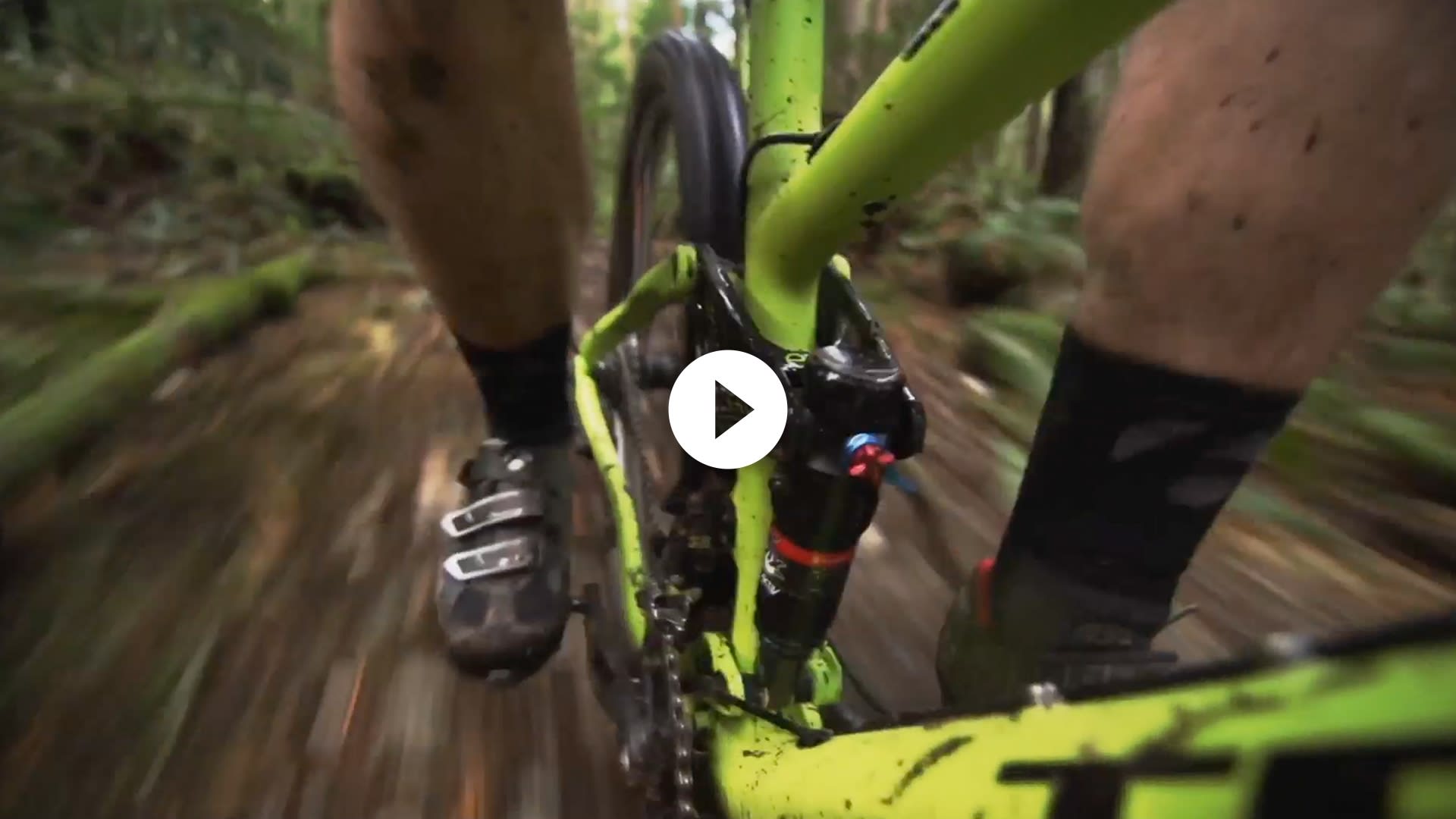
From the racetrack to the gravity park
What do Formula One and mountain biking have in common? Both sports put extreme demands on suspension systems, requiring the utmost stability and control in straights and corners, coupled with the capability to instantaneously respond to sudden bumps. For years, the ultimate challenge for mountain bike suspension engineers has been designing a shock that is firm and supportive while pedalling and in the corners, but capable of being plush and yielding to handle sudden impacts without knocking you off your line. RE:aktiv is the most efficient technology to do just that. What inertia valves attempted for years has finally been achieved. The RE:aktiv ride is firm under pedalling efforts, but provides a smooth, instantaneous transition to plush control, giving you the confidence to ride your bike as it should be ridden. The key point is that RE:aktiv gives you the best of both worlds all the time. It is not two settings, but an integral part of the rear shock’s design that ensures you’re ready for any obstacle the trail throws your way. Developed in collaboration with the experts at Penske Racing Shocks, the global leader in custom design for auto racing suspension, and FOX, RE:aktiv is the result of the best minds in suspension design, seeking out the most refined damping technology that mountain biking has ever seen.
Regressive Damping & Formula 1
RE:aktiv’s intuitiveness is a product of its regressive damping system. Proven in the demanding crucible of F1 circuits, regressive damping is dynamic and versatile. Most mountain bike suspension systems employ progressive or digressive damping, which simply do not respond as efficiently to a variety of obstacles. Such systems also have a difficult time transitioning from the active, support and control suspension action required in corners to the pedalling efficiency necessary to regain speed on straightaways or less technical sections of trail. When Trek’s engineers realised how effective this technology was in Formula One—where drivers encounter bumps and fly into corners at 200 mph (320 kph)—they knew it had an application in our sport. Penske Racing Shocks is the best, so a partnership was formed and prototypes were developed. FOX and Trek brought the expertise needed to scale up Penske’s custom designs, and RE:aktiv was born.
Regressive damping is the most adaptive
Effective damping is a vital component of suspension performance. Damping makes your ride rigid when on the pedals, but it stands in your way when confronting obstacles or ripping through corners. Regressive damping works when it should, and only when it should, because its engagement is sensitive to shaft velocity. What affects shaft velocity? Most rider inputs, like pedalling, produce low velocity, whereas most environmental inputs are the result of encounters with eruptive shapes, and result in high shaft velocity. With RE:aktiv, inputs that produce low shaft velocity do not affect performance but a threshold exists where anything that exceeds it immediately and dramatically changes the function of the shock. A sudden increase of shaft velocity—or how quickly the shock is trying to compress—opens the suspension up and allows for a supple and controlled response. It’s like having two different shocks on your bike. Normal rider input cannot produce enough velocity through pedalling to open the shock, which is the basis for RE:aktiv’s ability to distinguish pedalling from environmental inputs that require suspension engagement. When abrupt obstacles are encountered, the shock gets out of its own way. The process reverses as quickly as it begins, meaning that you don’t lose it on the obstacle but don’t sacrifice efficiency in the transition either. The speed of this transition is what gives RE:aktiv its unique feel—one that riders have been seeking for years.
No hesitation
For years, inertia valves provided damping in mountain bike suspension. While this technology is very good at keeping closed and providing efficiency, it is not successful in adapting to changes in the terrain. RE:aktiv was designed to address the primary drawback of these systems—they require too much input to engage. Because inertia valves respond to G-force, the shock often fails to open up when it should. Your shock may not fully engage until the second or third hit of a techy section, and you sacrifice control and feedback in the meantime. The problem persists on the other end of the obstacle or corner, where a lag period occurs before the shock realises it is no longer needed and the damping function re-engages. Essentially, inertia valves work, they’re just slow to recognise what’s happening around them. They become easily confused in off-road applications because they don’t easily identify different inputs, and don’t know whether to close or open on variable terrain. Simply put, other technologies lack the intuitiveness and immediate response that RE:aktiv provides.
Set and forget
RE:aktiv was designed to complement existing suspension settings, such as climb and trail modes. RE:aktiv can function effectively in all three settings, allowing you to simply pick the proper setting and let her rip. Wouldn’t it be nice to no longer interrupt your flow to flip between suspension settings during a ride? It simply makes the shock better all the time.
Where will I find RE:aktiv
RE:aktiv is a Trek exclusive developed for seamless integration into our full-suspension frames. Select models of Fuel EX, Remedy and Farley EX currently feature the technology.
Want a rugged, capable long-travel trail bike and a nimble XC bike? Get both with Fuel EX. Whether it's your millionth mile on the trail or your first, you'll love this bike.
Want to push harder? Want more travel? Ready to step up a level? Remedy is your full suspension express ride to the next level.
This ride is built to dominate: the mountain, gravity, your limits, the guy with #1 on his numberplate. Throw Slash down the most technical descent, fly back up. And win.

IMAGES
VIDEO
COMMENTS
Regressive Damping & Formula 1. RE:aktiv's intuitiveness is a product of its regressive damping system. Proven in the demanding crucible of F1 circuits, regressive damping is dynamic and versatile. Most mountain bike suspension systems employ progressive or digressive damping, which simply do not respond as efficiently to a variety of obstacles.
The RE:aktiv shock felt noticeably different than the normal DRCV unit within the first rooty half mile of trail in North Carolina, but it's taken several rides to really feel the nuances of what make RE:aktiv so good. The concept is essentially the Holy Grail of suspension: Provide support against pedaling and g-outs, but be sensitive to ...
RockShox Deluxe Re:Aktiv Thru Shaft 230 x 57.5mm Shock. $629.99. Model W572656. Retailer prices may vary. Custom tuned by Trek Suspension Lab. Compare. Color / Black. Select a color. Order now or check below to see what's in stock at your local shop.
RockShox Deluxe Re:Aktiv Thru Shaft 230 x 57.5mm Shock; RockShox Deluxe Re:Aktiv Thru Shaft 230 x 57.5mm Shock; We'll take care of you. Period. ... We're always here to help you. It's the Trek way. 30 Day Unconditional Guarantee. Ride it and love it, or we'll take it back. If for any reason you're not 100% happy with your trekbikes.com purchase ...
2101 posts · Joined 2006. #12 · Jan 4, 2021. The reaktiv valve is pretty bad, but nowhere near as problematic as the thru shaft design, which is the most unreliable shock I've ever seen. I don't publicly rubbish many products but I advise anyone looking at buying a trek to budget for a new shock in the purchase price.
Trek's RE:aktiv Suspension technology, derives its undisputable, high-performance features from F1 cars. It volumes out how a rear shock should perform, and sets the pace, in the race for the best shock technology! The RE:aktiv Suspension technology, was just one of those things I couldn't have over looked while I tested Trek's Fuel EX 9.8.
Trek uses a Trunnion mount for the shock to allow for a more stable platform and a mechanical, remote, under-the-bar lockout to toggle between the two settings on the fly. This shock design is only available on Trek's Top Fuel line. On the Trail: We tested the RE:aktiv XC on a Trek Top Fuel that we have used for long-term testing. Initially ...
After just explaining how an IFP works in our Suspension Tech series, Trek's gone and done away with it altogether. Their new RE:aktiv shocks, co-developed with Penske and made for them by both Rockshox and Fox, use a through-shaft design to eliminate the need for a compressible overflow chamber. Thru shocks are used in Formula One, short ...
Trek RE:aktiv Thru Shock Suspension Founded in 1975, Trek has a history of invention, innovation, and collaboration with stellar creative geniuses like Gary Fisher, Gary Klein, Keith Bontrager, and Greg LeMond to name a few. They've built bike frames from steel, aluminum, and developed their own proprietary process for manufacturing carbon fiber frames in the USA.
Trek's 2018 bikes with RE:aktiv Thru-shaft shocks include the Slash 9.8, Slash 9.7, Remedy 9.8, Remedy 9.8 Women's and Fuel EX 9.9, as well as carbon framesets. The thru-shaft equipped models ...
The 2018 Trek Remedy 9.8 sports the highly praised GX Eagle drivetrain but the big news is Trek's new Thru Shaft shock. This isn't a review of the Remedy per se. Pete tested a 2017 model with the same frame and you can read about the ins-and-outs of the bike here. I'm specifically looking at the big change in Trek's full suspension line for ...
Pricing starts with the EX 7 27.5 at $2,629.99, up to the $5,249.99 Fuel EX 9.8 27.5. If you're looking for the RE:aktiv shock technology however, you will only find it on the EX 9 and EX 9.8, the 7 and 8 models stick with the standard Fox DRCV technology. Sold in the same sizes as the Fuel EX 29 with the exception of the 23″ frame, select ...
For 2018/19 Trek has exclusive use of a new technology compressed down from motor racing and into mountain bike suspension. RE:aktiv adds the 'Thru Shaft' label, which is a replacement for ...
Building on their past history of incorporating suspension tech from F1 and auto racing, Trek Bikes have launched a new iteration of their RE:aktiv shocks. By dropping the internal floating piston found in most other shock designs and using a suspension concept currently found on Moto GP bikes, Trek claims that their new Re:aktiv Thru Shaft ...
TKTV = Model - Trek Thru Shaft RE:aktiv A1 = Version - (A - first generation, 1 - first iteration) To identify the model code, locate the serial number on the product and enter it into the Search by Model Name or Serial Number field at ... If your shock will not return to full extension, do not attempt to service or disassemble your shock ...
398-00-748. Service tooling: Trek Thru Shaft IFP Bleed Screw Torque tool. 398-00-749. Service tooling: Trek Thru Shaft IFP removal tool. 803-00-806. Kit: Tooling, iCD/CTD Dish Shock Dial Indicator Attachment for Plate Lift Measurement. 803-00-805. Kit: Shaft Clamps, Shocks, CTD 9mm, 3/8in, 1/2in, 5/8in. Oil Info:
Pace. A huge aspect that nearly everyone mentions when asked is that the pace of life in Moscow is faster. In Petersburg, people are less pushy and will stop and smell the roses, while in Moscow, everything is important and urgent and everyone walks at lightning speed. Probably the largest contributing factor to this is each city's population ...
March 25, 1953 Soviet Government decided to suspend the construction of the railroad. The last prisoners left these places in 1955. The constructed sections of the railway were abandoned. There is no official data on the number of deaths in construction. Rough estimate ranges from 60,000 to 100,000 for the period of 1947-1953.
CNN —. Russia has been left reeling in the wake of the nation's worst terrorist attack in decades. ISIS has claimed responsibility for the massacre, which saw armed assailants storm a popular ...
Khoroshyovsky District is an administrative district of Northern Administrative Okrug, and one of the 125 raions of Moscow, Russia.It is 6 kilometers northwest of the Moscow city center. Central to the district is Khodynka Field, which, as an open space in the northwest of Moscow was long the site of agriculture, battles, celebrations and the first airfield in Russia.
Regressive Damping & Formula 1. RE:aktiv's intuitiveness is a product of its regressive damping system. Proven in the demanding crucible of F1 circuits, regressive damping is dynamic and versatile. Most mountain bike suspension systems employ progressive or digressive damping, which simply do not respond as efficiently to a variety of obstacles.